The Opera Garnier Guided Tour
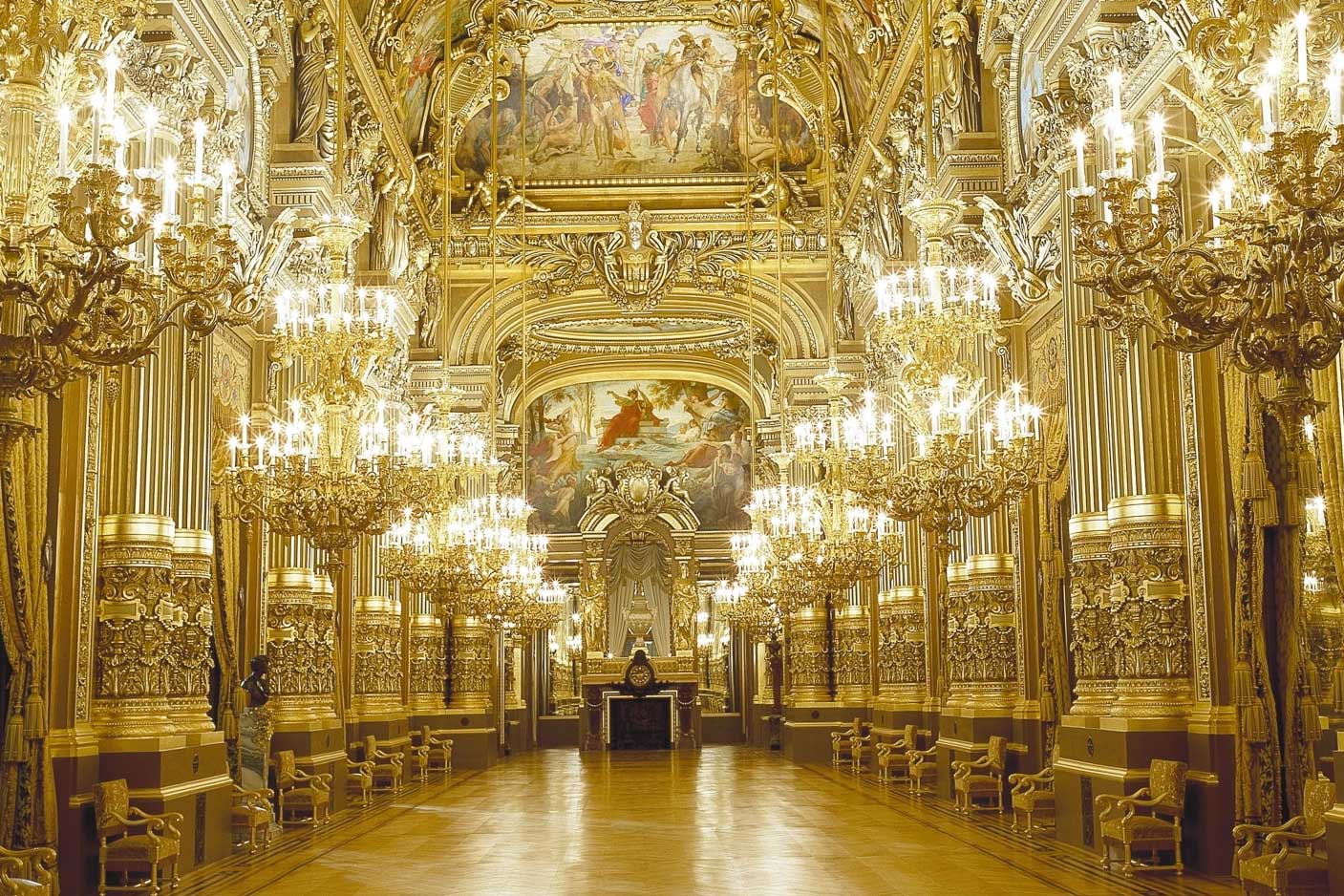
- Information
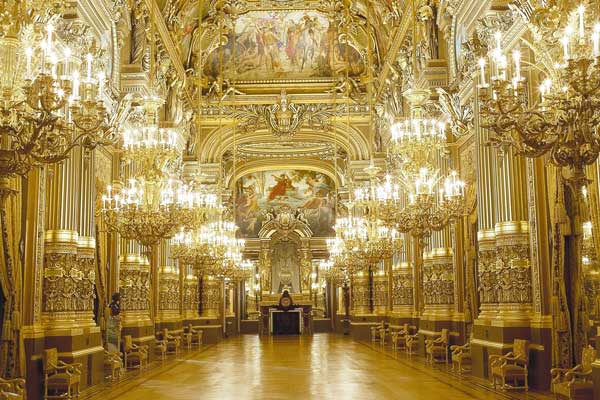
Theatre tour
Recommended for all ages
In French or English

Highlights: The Opera Garnier Guided Tour
Welcome to the most prestigious opera and ballet house in all of Paris! Book a tour with a professional guide to discover the historical and architectural wonders of the ornate Palais Garnier. Should you choose to visit the Opéra Garnier at 5 p.m., after its doors are shut to the public, your guide will take you on a journey following the footsteps of Erik – the famed Phantom of the Opera from Gaston Leroux's novel! Visit the Palais Garnier to uncover the secrets and myths of this palace that seems to transcend time itself…
Story: The Opera Garnier Guided Tour
Built in 1875 by architect Charles Garnier, the Palais Garnier is the largest opera house in Europe, housing more than 2,000 seats under its elaborate roof. As well as being regarded as the most prestigious of Paris' theatres, the Opéra Garnier is also one of the capital's most emblematic monuments, a museum in its own right with a spectacular selection of paintings, sculptures, and fascinating architectural features.
Your tour begins at the Rotonde des Abonnés, a glorious vestibule which once served as the audience entrance. Your guide will then lead you to the fascinating statue of the Pythia, and then to the Grand Escalier - a lavish split staircase with grandiose decor, featuring marble, onyx, copper, paintings, gilding, and mosaics. At its summit, you will then reach the Grand Foyer. You may find that its splendor and captivating use of mirrors and windows are reminiscent of the Hall of Mirrors at the Château de Versailles. Technical and artistic conditions permitting, you will also have access to the auditorium.
To make your visit to the Paris opera an exquisitely unique experience, you can choose to visit in the evening (5 p.m.), after the Palais Garnier is closed to the public. Your guide will take you on a tour in the footsteps of the Phantom of the Opera, the titular character from the celebrated novel by Gaston Leroux. As you discover the secrets and anecdotes of this historically and culturally rich palace, you will enjoy the rare privilege of having the entire monument to yourself, and exclusive access to the dressing room number 5 – that of the ghost himself. This tour offers you a rare opportunity to learn all of the facts and secrets about Paris' most revered (and most mysterious!) monument from an insider's perspective. What are you waiting for…?
Book a guided tour for your group of 10+ people!
Fancy sharing your trip to the Opera de Paris with friends? Look no further - Theatre in Paris offers guided group tours of this architectural relic! Indulge in an unparalleled journey through time with your closest companions and marvel as the secrets and surprises of this enchanting edifice unfold before your very eyes… a beautiful experience to share with friends and family. Enjoy reduced rates for larger groups - get in touch!
Contact us at [email protected] to make your reservation! If you are interested in booking for a group of 10 or more people , we ask that you please book at least 45 days in advance . For groups of any size, we strongly recommend booking in advance of your desired dates to guarantee your place. We’ll see you there…!
There are not yet any reviews for this show, be the very first to share a review by completing the following:
Opéra Palais Garnier
One of the most prestigious stages in all of France, the Palais Garnier was constructed between 1860 and 1875, designed by legendary architect Charles Garnier, who was selected among a handful of talented architects in a fierce design competition. The building itself is considered an artful masterpiece, and was one of the most expensive construction projects to come from the Second French Empire under the reign of Napoléon III. The elaborate use of different materials to lend a lavish multicolored facade was typical of many of the works under the rule of Napoléon III, and features sculptures of various figures of Greek mythology. The official inauguration in 1875 was attended by the Mayor of London and Amsterdam, the King Alphonso XII of Spain, and hundreds of members from European high society.
The interior was meticulously designed with intertwining corridors, alcoves and landings to allow for easy movement of large numbers of people; complete with a grand marble staircase and the grand foyer, acting as the drawing room for all of Paris high society and covered in gilded paintings. The auditorium itself is in a traditional Italian horseshoe shape, seating 1900. The stage is the largest in Europe and can accommodate 450 artists, revealed by the opening of the legendary painted curtain. Garnier himself designed the 7-tonne chandelier sparkling above the audience. In 1896, one of the many chandelier counterweights broke free and killed a concierge, the incident that inspired the scenes in the 1910 novel-turned-musical The Phantom of the Opera . The space above the auditorium in the copula dome was once used strictly for cleaning the chandelier, but has since been transformed into a space for opera and dance rehearsals.
The legendary building was initially deemed the Academie Impériale de Musique, yet with the fall of the Second Empire and the start of the Third Republic, this was aptly changed for the Academie Nationale de Musique, which we see written across the exterior facade to this day. Garnier envisioned his design and the transformation of the surrounding area, and to this day the opulence of the Second Empire lives on in this living monument. The avenue de l'Opéra remains the only large Parisian corridor without trees, as Garnier explicitly prevented Haussmann from adorning the street with trees, arguing that his Palais Garnier was to be the main focus. Palais Garnier became the official name in 1989 with the construction of the Opéra Bastille, and the venue now houses primarily ballets.
Fast facts Capacity: 1,979 Handicap Accessible: Yes – in order to guarantee access to specific locations, we ask that you make your reservation at least 15 days before the performance. Air conditioning: Yes Heating: Yes Coat Check: Yes (free service)

How do I get to the venue?
The Palais Garnier is accessible by the metro station Opéra (Lines 3, 7, 8) and Auber (RER Line A). Our hotline can be reached in case of difficulty finding the venue weekdays from 10 am to 7pm Paris time. For details, we invite you to consult the map above.
What do I do when I get to the venue?
We invite you to arrive 30 minutes before the beginning of the tour. Once you have entered the building, the meeting point with your guide is located at the Rotonde des Abonnés. Please present your voucher to the guide upon your arrival.
How long does the tour last?
The guided tour of the Palais Garnier Opera House lasts 1 hour 20 minutes.
Is it a guided tour of the Palais Garnier for tourists or French people?
Both! The Palais Garnier is an iconic monument of Paris, visited as much by travelers as by the local public. Tours are offered in French or English, usually at different times. The language is indicated in the price list after you select a day and time to visit when you make your reservation, so be sure to check your choice.
Is it possible to visit the theatre and backstage?

A Worthwhile Guided Tour: Paris Opera House (Palais Garnier)
I much prefer taking guided tours when I travel because the learning is interactive. I often start to daydream when the self-guided audio-tour I’ve been given goes on and on and on. After a while it just becomes boring and I zone out. That’s why I especially liked taking the guided tour of the Paris Opera House (Palais Garnier), which, according to Tripadvisor, is #4 on the list of top attractions in Paris attracting almost 480,000 visitors a year.
The in-depth, expert commentary about the building’s creation, architecture, and history was one thing. But being able to ask questions and discuss things with our tour guide made the experience more meaningful and worthwhile and our tour guide really brought the building and history to life. If you’re going to do a guided tour, do it at the Palais Garnier, considered one of the world’s grandest theatres.
*This post contains affiliate links. If you make a purchase through these links, I get a small commission at no extra charge to you. It helps support the running of this website and I do appreciate your help.*
1. Palais Garnier Opera House Tour, Paris
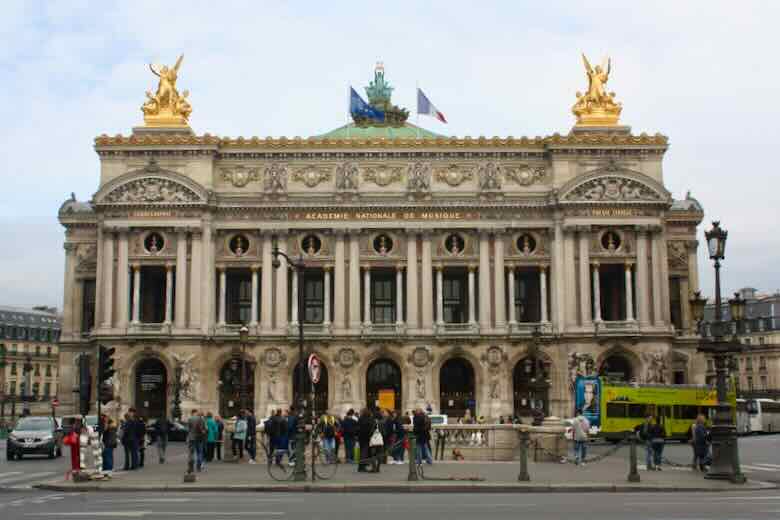
About a month before visiting the Paris Opera House, my niece, her husband, and I ordered tickets online for the guided tour. We chose one of the morning, English-speaking tours. In addition to French and English tours, there are also Spanish-speaking tours with a maximum of 30 people. The cost of the guided tour is currently 18.5 € and the self-guided visit is 14 € where you get access to the public areas and any exhibitions going on.
With the self-guided tour, you can pay an extra 6.5 € to get a tablet which will provide you with a 1 hour multi-media tour through the opera. So it’s actually quite reasonable to take the guided tour.
We arrived 30 minutes before the tour was to start to exchange our voucher for our tickets. We then had to go through security and join the other ticket-holders in a waiting area, the Rotonde des Abbonées.
Consider Booking Tickets To See A Show At The Palais Garnier : Really keen on seeing a ballet, a concert, an opera, or even demonstrations of the Paris Opera Dance School at the Palais Garnier? Check out what’s available and the best prices here: Performances At Palais Garnier .
(a) The Rotonde des Abbonées
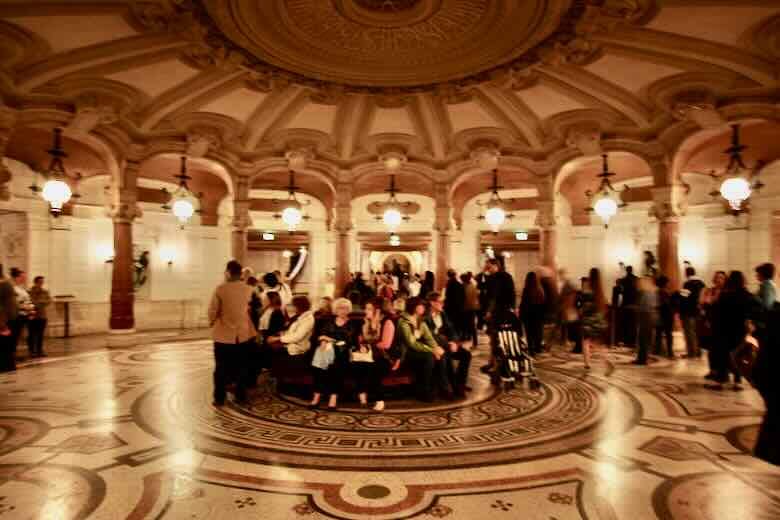
The Rotonde des Abbonées is a circular room or vestibule that has pillars on the perimeter, mosaic tiles on the floor, and a very decorative ceiling. Throughout much of the Paris Opera there are symbols of Greek mythology and as you head to the Grand Escalier (Grand Staircase) you pass by La Pythonisse (or Pythia), priestess of the god Apollo greets you.
Interesting fact #1 : the Pythia sculpture was done in bronze by Marcello who was actually a woman, Adèle d’Affry, the Duchess Castiglione-Colonna.
You might also like to read these posts: – What’s So Special About The Wallace Fountains In Paris? Free Water – Where You’ll See Famous Arches In France – Best Views Of Paris? From The Pantheon Dome
(b) Special Headphones
Our tour guide spoke excellent English and explained how the opera house can get very busy and crowded and rather than try to speak over all the voices, she would speak into a microphone and we would be able to clearly hear her using special headphones. These headsets amplified her voice but her words remained very clear. And no matter how close or far we were from her, we could hear her.
We did have to provide her with a piece of identification (ie. license or passport) that she held onto in exchange for the headphones. This is not uncommon when you borrow audio-guides at museums.
During our 90 minute tour, was informative and provided interesting commentary. Of course, she elaborated on the Phantom of the Opera and parts of the story that were true and not true. She took us to various areas and rooms and gave us time to take photos, wander around a bit, and ask questions.
2. History Of Palais Garnier
She began our tour by telling us some stories about the opera’s history. Napoleon III was on a mission to reconstruct and modernize Paris, adding sewers, creating grand boulevards and more light to the area. This was done with the help of Baron Haussmann.
A competition was established to choose a design for the new Opera House. There would be 2 phrases where applicants would be narrowed down to 7 in the 2nd phase. Architect Charles Garnier was one of 7 finalists and after revising his project, it was finally selected as the winning design. He began construction of the Opera in 1861.
The Paris Opera house was one of the most expensive buildings to be built at a cost of 7.5 million francs.
Interesting fact #2: the Opera House was so expensive that the government had to borrow over half of the money (4.9 million francs) from wealthy entrepreneur, François Blanc, who managed Monaco’s Monte Carlo Casino.
Palais Garnier was finally completed January 5, 1875. Electrical lighting was installed in 1881. Up until then gas lighting was used. The opera house was originally called Salle des Capucines but became known as the Palais Garnier, named after the architect.
Interesting fact #3 : during the construction, water kept seeping into the basement, and eventually a pond was formed and Garnier decided to create an artificial reservoir or pond to hold the water.
Interesting fact #4 : in 1896, a part of an enormous chandelier—a counterweight—broke free and fell, killing one person. In 1910, author Gaston Leroux used the area of water or “lake” of stores as well as the chandelier incident as inspiration for his famous story, Le Fantôme de l’Opéra (The Phantom of the Opera). The story and Andrew Lloyd Webber’s musical of the same name has certainly made the Palais Garnier even more famous.
The Paris Opera House is one of the largest and opulent opera houses in Europe, seating almost 2000 people. It became a national heritage site—“Monument Historique“— in 1923.
3. The Highlights Of The Palais Garnier
We were brought to various rooms and areas in the building, including the famed auditorium, where you can see the famous painting that Marc Chagall did on the ceiling. The style of the architecture throughout was eclectic with a mix of Greek, Baroque, Renaissance, and Beaux-Arts styles.
(a) Grand Escalier (Staircase)

As you climb the Grand Staircase from La Rotonde des Abbonées, you are presented with additional staircases and landings which take you to the different floors, salons, and foyers. The staircases are made primarily of white marble with additional added coloured marble columns (balustrade) supporting the railings. There are two female sculptures, dressed in robes, on each side of the entrance to the orchestra and balconies.
This whole area was for socializing before the performance. Spectators were surrounded by broad staircases, painted ceilings, and elaborate chandeliers.

Newsletter community members get access to free exclusive content like this bonus, “Top 10 Photo Locations In Paris” cheat sheet. Sign up now!
(b) Ceilings

Remember to look UP in the Opera house where ever you are because you’ll see elaborate ceilings and enormous chandeliers. The ceiling above the Grand Staircase was done in 4 panels with scenes from Greek mythology by Isidore Pils (1815-1875).
Interesting fact #5: part way through the painting of the ceiling, Pils became ill and his students (many who became famous in their own right), had to finish his work.
(c) Grand Foyer

The Grand Foyer is quite impressive and ornate. It reminds me of Château de Versaille’s Hall of Mirrors where the light streams through the many windows and illuminates the many chandeliers, gold painted pillars and walls, grand mirrors, and the colourfully decorated paintings on the ceiling by Paul-Jacques-Aimé Baudry (1828-1886).
(d) Salon du Glacier
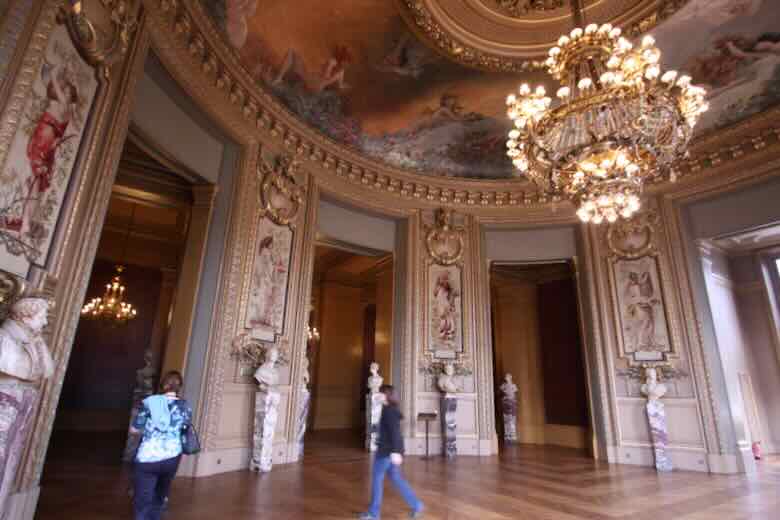
The Galleria du Glacier is a long hallway featuring elements and designs of the Belle Époque and it leads to the Salon du Glacier, a rotunda that was opened after the opening of the Opera House. It has another large chandelier and an decorated ceiling painted by Georges Clairin (1843-1919). In this area there are also marble busts, tapestries of hunting and fishing scenes and paintings of dancing Greek Bacchantes.
(e) Library-Museum Of The Paris Opera
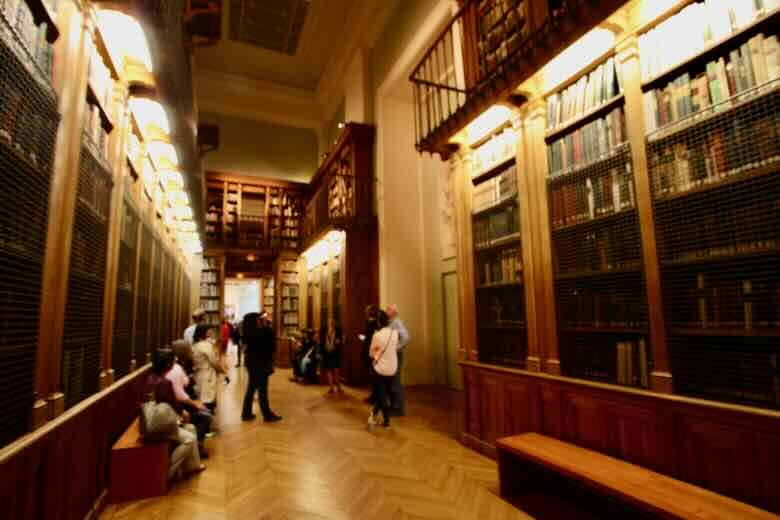
Quite surprising to many of us was that the Paris Opera is also a library-museum (Bibliotèque-Musée de l’Opera de Paris). There are many sites that belong to the Bibliothèque nationale de France (National Library of France) including the Richelieu Library which I recommend visiting so you can see the magnificent Labrouste Reading Room (the Salle Labrouste).
This particular library and museum contains hundreds of thousands of documents, paintings, photographs, letters, and other items which date back hundreds of years.
(f) Auditorium: Marc Chagall’s Painting On The Ceiling
One of the items on display in the Library-museum is actually the initial ceiling for the auditorium. It was painted by Jules-Eugene Lenepveu and was called, “The Muses and the Hours of the Day and Night”.
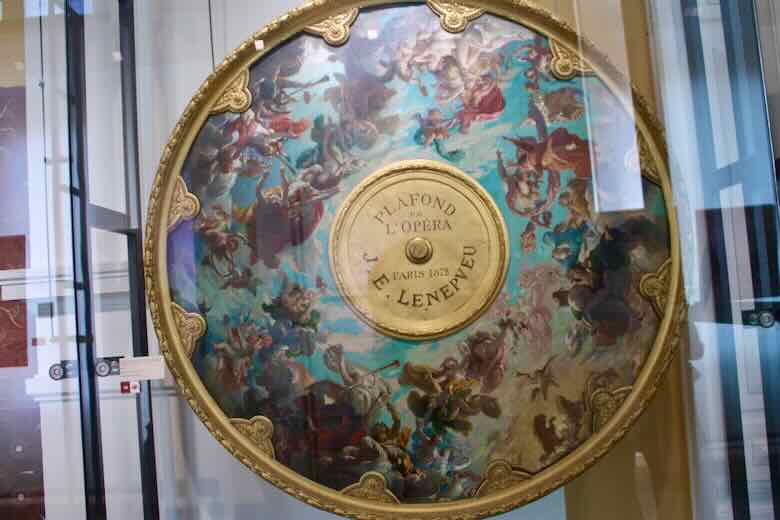
Interesting fact #6: Lenepveu’s painting was considered too old-fashioned and in 1964, French Culture Minister, André Malraux, commissioned artists Marc Chagall to paint a new ceiling. This is the painting that is there today; however, there continues to be controversy about the painting and whether it is appropriate for its surroundings, where many consider it too modern.
The chandelier in the centre has 340 lights, weighs 8 tons, and is made of bronze and crystal. At the time it cost 30,000 francs. Even the chandelier had controversy. There were complaints that the chandelier obstructed the view and Lenepveu’s painting of the ceiling by those sitting in the box seats on the fourth level.
There is NO guarantee that you will have access to the auditorium on the self-guided or guided tours as there could be rehearsals going on. We were fortunate to be able to visit it and sit on the very plush seats.
Our tour also allowed us to “peak” into one of the opera boxes) which are located on the side or facing the stage called loge de côté and loges de face)—-a separate room where 4-6 guests can watch a performance in the privacy of their own “space”. You might also be able to visit box #5, which is the Phantom’s box in the story. The plaque on the door, “Loge du Fantôme de l’Opera” indicates the box is reserved for the Phantom.
4. Attend A Performance At The Paris Opera House
We didn’t really have much time to gaze around the horseshoe-shaped auditorium; however, many years before this tour, I did attend a ballet with a friend.
When we arrived at the Opera, we couldn’t get a ticket for a tour, but we could get last-minute tickets to see a performance by the American Ballet, so we bought tickets. Our box was very high up and we had it all to ourselves. I will be very honest and say I had to leave early. It was in the summertime and the heat was just too much. (Remember, hot air rises!) I was getting faint! It was a long time ago and there wasn’t air conditioning.
Does the Palais Garnier have air conditioning today? I have heard yes, however, if you are on one of the highest levels it can still get stuffy and hot in those boxes. The only downside of seeing the ballet was that we didn’t really get to see all the salons, rooms, and areas of the Opera House, which is why I did the tour many years later.
5. The “Other” Opera House: Opera Bastille
There is another opera house in Paris. In 1989 the Opera Bastille was constructed and is located at Place de la Bastille. This is now the location for operas. Palais Garnier is primarily used for ballet performances.
Between 1994 and 2007 major renovations were made on the Palais Garnier to modernize the stage, improve the electrical components, and reinforce the structure and foundation. The architecture is stunning and the Opera House Paris tour is well worth the 18.5€ . On the Palais Garnier website you can see that their calendar indicates the number of available spots on the tour and quite often many are available.
6. Paris Opera House (Palais Garnier)
- Visit The Palais Garnier (website) : https://www.operadeparis.fr/en/visits/palais-garnier
- Hours: open daily 10:00-5:00 (and 10-6 pm in the summer) except for afternoons when there are performances
- Most guided tours: are at 2:00 pm.
- Cost for the guided tour tickets : 18.5€*
- Reduced rate: if you have a ticket from the Musée d’Orsay or Musée Gustave Moreau that is not greater than 8 days old you can save a few Euros on the cost of your ticket.
- To check out what shows you can see and the best prices, click here : Performances At Palais Garnier .
- Address : Place de l’Opera
*Prices are subject to change.
Check out my post about booking tours in advance for more information: Trip Advice Part 1
TRAVEL RESOURCES Booking.com and Expedia : are the companies I use for finding accommodations. VRBO : is super for booking apartments and houses. AutoEurope : is the only car rental supplier that I will use–with the best prices, and they will refund the difference if the price goes down. Trainline : offers an easy way to book train tickets. Get Your Guide and Viator : Both offer tours, city cards, tickets, airport pickups, and so many other things you’ll need at your destination. Orange SIM Card -this is the company I use when I want a physical SIM card Airalo eSIM -offers eSIMS and get great reviews
Pin to your favourite board on Pinterest
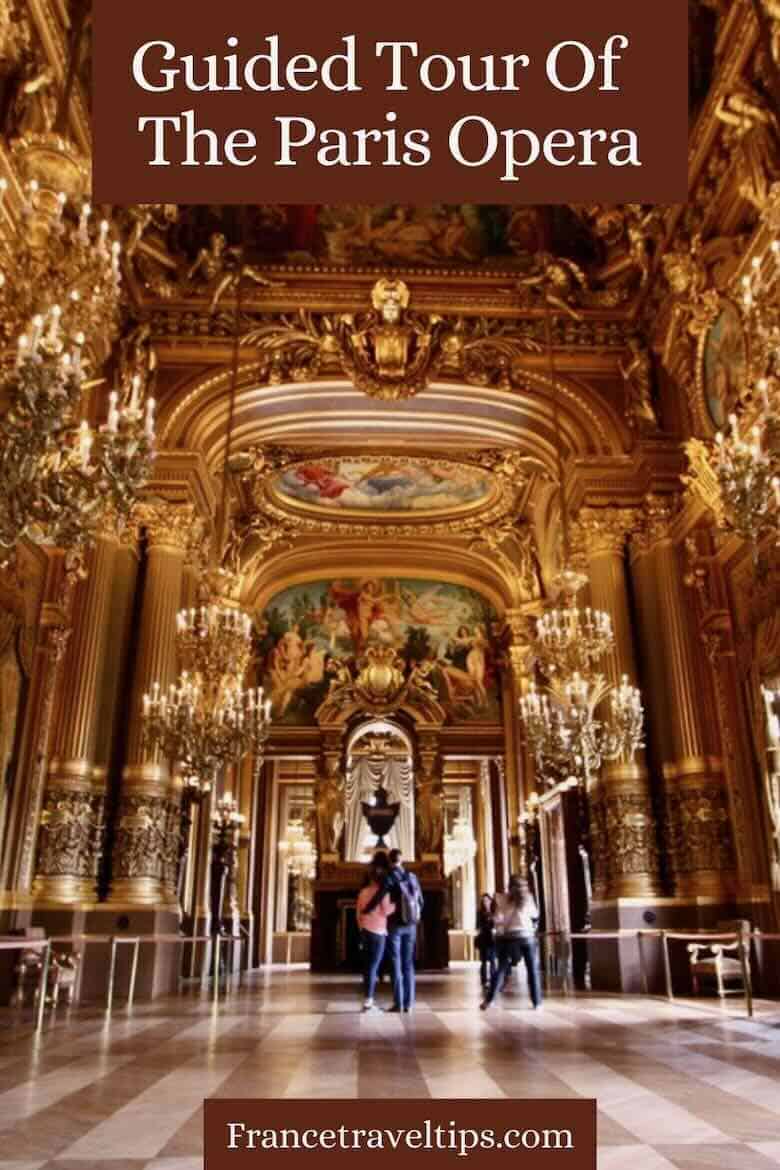
Share this post:
I've travelled to France over 35 times and love sharing my tips and unique experiences not always mentioned in travel guides. You can learn more about me by visiting my About Page . Subscribe to join my newsletter. Community members get access to free exclusive content and bonuses.
Similar Posts

Unique Things To Do In Dijon (When You Have 1-2 Days)

36 Hour Stopover In Collioure
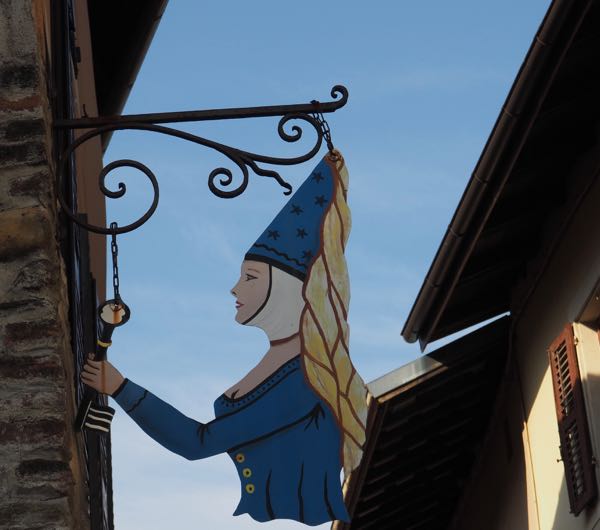
Cité Medievale de Conflans In Albertville
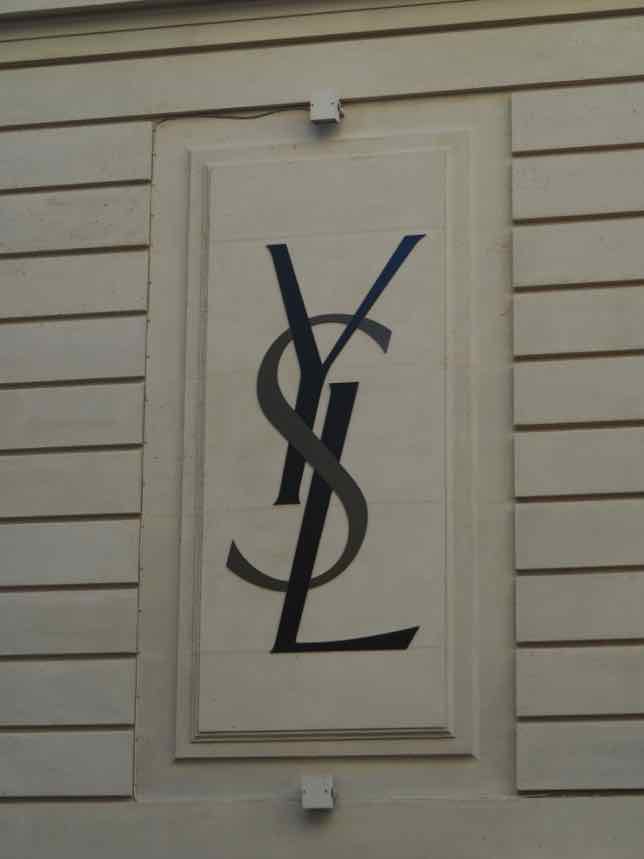
Visiting The Yves Saint Laurent Museum In Paris

8 Interesting Exhibits At The Arts et Métiers Museum
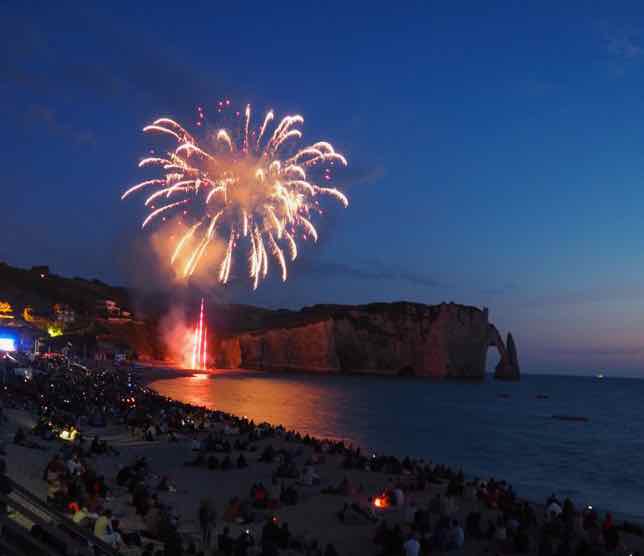
Where To See The Best Bastille Day Fireworks In Normandy
Leave a reply cancel reply.
Your email address will not be published. Required fields are marked *
- Concerts and Recitals
- Young Audiences
- Opéra Bastille
- Amphithéâtre Olivier Messiaen
- Palais Garnier
- Philharmonie de Paris
- Studio Bastille
- Monday
- Tuesday
- Wednesday
- Thursday
- Friday
- Saturday
- Sunday

Don Giovanni
Pre-opening young

Opening Show

Don Pasquale

Opening Gala

Marion Motin / Xie Xin / Crystal Pite

Season's opening concert
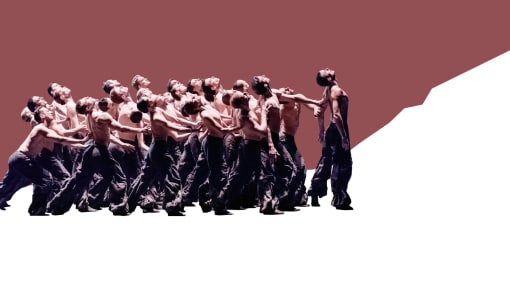
Génération 1685

Musical encounter October 5

The Makropulos Case

La Mort rouge

Brahms Concert

Public rehearsal: In the night

Musical encounter October 19

Public rehearsal: Paris Opera Ballet School

Jerome Robbins

First time at OnP
Audiodescription

Musical encounter November 9

Ma Mère l'Oye / L'Enfant et les Sortilèges

Halloween Parc

Bach: cantatas

Les Contes d'Hoffmann

Les Nations

Public rehearsal: The Nutcracker

Vissi d’arte – Gala Maria Callas

Paris Opera Ballet School Demonstrations

Swan language, keys to the show

Musical encounter December 7

Jiří Kylián Evening

The Nutcracker

Swan Language

Holiday concert

Béjart Ballet Lausanne

Adriana Lecouvreur

Giulio Cesare

La Traviata
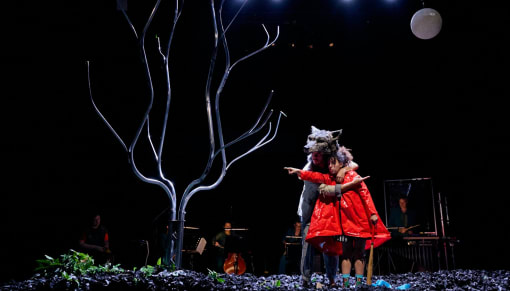
La petite fille, le chasseur et le loup, keys to the show

Opera arias and ensembles

Musical encounter January 25
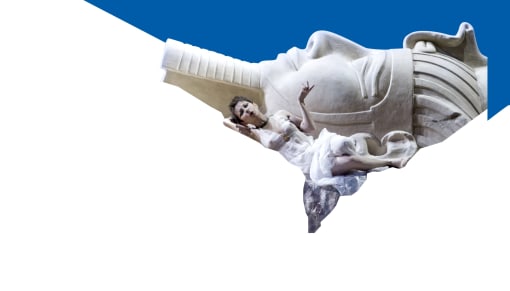
La petite fille, le chasseur et le loup

Beatrice di Tenda
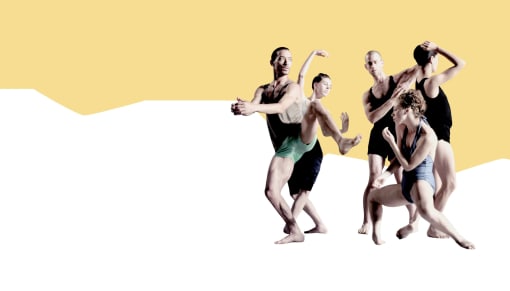
Bastille Metropolitan

Public rehearsal: Swan Lake

Métamorphoses

The Exterminating Angel

Projet Pinocchio

Simon Boccanegra

La Fille mal gardée

Le Petit Bain

Musical encounter March 21

Don Quixote

Musical encounter March 28

Public rehearsal: Don Quixote

Concert à la Philharmonie de Paris

Musical encounter April 4

Paris Opera Ballet School Production

Public class with students from dance schools of the 21st century

Dance School Gala

Dancers Choreographers - program 1

Dancers Choreographers - program 2

Je suis tous les dieux

No tickets currently available

Don Quichotte

Musical encounter May 16

Fauré Concert

Booking Start For
William forsythe / johan inger, madama butterfly, la fille du régiment, les brigands.

NezQuiCoule

Booking Start For Pre-opening of

Così fan tutte

On sale 30/05/2024 from 12:00

Musical encounter June 13

Concert ADO

The Magic Flute
The rake's progress.

On sale 06/06/2024 from 12:00
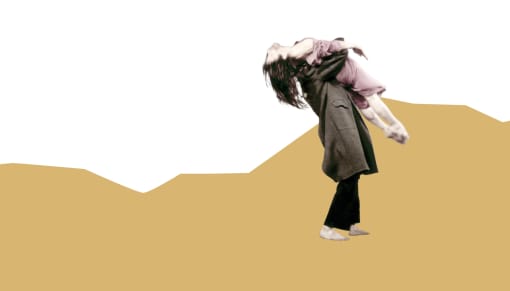
Ostufer: Wohnblock IV
Dmitri shostakovich, musical encounter october 3, tribute to gabriel fauré, musical encounter october 17, musical encounter november 7, musical encounter november 21, benjamin bernheim, musical encounter november 28, igor stravinsky, maurice ravel, musical encounter december 12, danube impérial et royal, bizet and his contemporaries, expressionist seasons, musical encounter february 6, musical encounter february 27, renée fleming, l'isola disabitata, splendours of the baroque, musical encounter march 27, natalie dessay, musical encounter april 3, fantasies along the river thames, transatlantic journey aboard the normandie, rolex ambassadors concert, elīna garanča, musical encounter may 22, musical encounter june 5, cordes à l’est, musical encounter june 26.

Musical encounter June 27

Visitor's Guide to the Opera Garnier in Paris
19th-Century Historic Building
:max_bytes(150000):strip_icc():format(webp)/profilepic-CTraub-5b6ff65d46e0fb00505577c1.jpg)
TripSavvy / Taylor McIntyre
Seating 2,200 people, the imposing Opera Garnier in Paris —also known as the Palais Garnier or simply the Paris Opera—is an architectural treasure and essential spot for the city's ballet and classical music scene.
Designed by Charles Garnier and inaugurated in 1875 as the Academie Nationale de Musique—Theatre de l'Opera (National Academy of Music–Opera Theater)—the neo-baroque style Opera Garnier is now the home of the Paris ballet. This does create some confusion for many tourists (ballet in the opera theater).
For anyone hoping to enjoy a Parisian Opera rendition of La Traviata or Mozart's The Magic Flute, the city's official opera company relocated to the starkly contemporary Opera Bastille in 1989.
Location and Contact Information
The Palais Garnier is located in Paris's relatively central 9th arrondissement, more or less directly north of the Tuileries Gardens and the adjoining Louvre Museum. It's one of the crowning attractions of the Opera-Haussmann neighborhood; one of Paris's most coveted shopping districts and the hub of major department stores like Galeries Lafayette and Printemps.
To make a morning or afternoon of it, you can visit the Opera, take a stroll around the old department stores, and have lunch in one of the gorgeous old 1900 brasseries in the vicinity (such as Cafe de la Paix, right across from the Opera). Then wander through the grand old streets in the vicinity—an area that's considered one of the crowning jewels of Haussmann's remodeled Paris.
- Address: 1, place de l'Opera, 9th arrondissement
- Metro: Opera, Pyramides or Havre-Caumartin
- Website : https://www.operadeparis.fr/en
Access, Opening Hours, and Tickets
Visitors can tour the main premises of the Opera Garnier during the day and visit the site's museum, either on an individual basis or as part of a guided tour.
Opening Hours
10 a.m. to 4:30 p.m. (September 10th to July 15th); 10 a.m. to 5:30 p.m. (July 15th to September 10th). Closed January 1st, May 1st. The cashier closes 30 minutes before the official closing time.
Ticket prices for ballet and other performances vary. Current performances at the Opera Garnier change so be sure to check to see what is upcoming.
Food and Dining
A recently opened restaurant situated on the Palais Garnier's eastern side (simply called "L'Opera") offers good-quality cuisine for breakfast, lunch, or dinner. Fixed-price menus are available at limited times.
Like This? Read These Related Features
Make sure to read our complete guide to Paris for music lovers , which gives you an excellent overview of the city's best venues, annual festivals, and more.
Music fans of all persuasions will love the Philharmonie de Paris, the latest newcomer to the city's art landscape and offering an eclectic program of musical performances, from classical to the world to rock. Meanwhile, if you want to enjoy contemporary opera in Paris, check out the boldly modern charms of the Opera Bastille.
Finally, for traditional French "chansons," dance, and late-night reveries check out our guide to the best traditional cabarets in Paris, from the Moulin Rouge to more avant-garde (and less expensive) revues like the Zebre de Belleville.
Top 15 Monuments and Historic Sites in Paris
All About the Jardin des Tuileries in Paris
Top 15 Things to Do at Night in Paris
Taking the Roissybus to or From Charles de Gaulle Airport
Luxury Shopping in Paris Boutiques and Stores
9 Places for Jewish History in Paris, From Museums to Memorials
A Self-Guided Tour of Parisian Architecture
May Events in Paris: Festivals, Sports & More
Paris for Music Lovers: A Complete Guide to Venues and Festivals
Review of Context Travel Walking Tour: The Making of Modern Paris
All About the Yves Saint Laurent Museum in Paris
The 7 Best Places for Shopping in Paris
Les Invalides in Paris: The Complete Guide
The Top 15 Things to Do in Bordeaux, France
18 Best Free Things to Do in Paris
Fragonard Perfume Museum in Paris

Visit The Palais Garnier
Almost 150 years old and classified as a historical monument since 1923, discover a dazzling and unrivaled place, in the very center of Paris: the Palais Garnier.
Discover a unique and prestigious place in the heart of Paris
Discover a unique and prestigious place in the heart of paris: the palais garnier. several visits are to be discovered: intermezzo visit to the palais garnier: through the rooms of the opera accessible to the public, discover the extraordinary history of the palais garnier, a monument of architecture and a total work of art. visit palais garnier in the belle epoque: go back in time with charles garnier, experience the atmosphere of the temple of social life in the 19th century, let yourself be transported and join the dance visit the mysteries of the palais garnier (after closing): discover all the secrets of the paris opera in this visit outside opening hours to the general public. in a cozy atmosphere discover or rediscover a timeless place. .

Intermezzo visit to the Palais Garnier
The Mysteries of the Palais Garnier

Palais Garnier in the Belle Epoque

Saut de Chat à l'Opéra (6-12 ans)
The palais garnier: a hymn to magic.
Initiated by Napoleon III after an attempted attack and inaugurated in January 1875, it was after 15 years of work carried out by Charles Garnier, an architect unknown at the time, that the Palais Garnier was born. Today, this building, also called Opéra Garnier is one of the most emblematic monuments of the 9th arrondissement.
Spread over an area of 11,000 m², this eclectic style building will charm you with its many influences: Louvre Museum, Palace of Versailles...
Enter the largest opera house in France and enjoy its famous grand staircase, the Bassin de la Pythie or its sumptuous grand foyer and lounges.
See all tours in Île de France
See all culture tours, also discover....

Printemps Haussmann

La Défense district
Individual rates & information, group rates, click here., adult , 23.00 €, 16.50 €, reduced price*, 10.00 €, less than 10 years old, 26.00 €, single price visit after closing, doors open at 10 a.m. due to vigipirate checks, please arrive 30 minutes before your visit time. luggage is not accepted on site and no lockers are available for security reasons. guided tours will take place with a maximum of 30 visitors per guide. due to the cultural programming of the opera, access to the performance hall cannot be guaranteed..
Prices applicable from 01/10/2023.
Free for children under 4 and accompanying disabled persons. * Under 25s, disabled people, seniors (over 65s), jobseekers, students.
Explorez l'Opéra Garnier avec vos élèves grâce à nos visites guidées !
Visite scolaire cycle 1 : .
Conçue pour les élèves de maternelle entre 3 et 6 ans, cette visite scolaire de Cycle 1 permettra à vos élèves de découvrir le Palais Garnier par une expérience sensorielle riche, en plaçant l’observation au centre de la visite. Celle-ci leur apprendra à mobiliser le langage en les poussant à mettre des mots sur leurs émotions, leurs sentiments et leurs impressions. Des mises en situation leur permettront d'apprendre et de découvrir en jouant, à travers les grandes notions en cours d’acquisition à l’école : les formes, les couleurs, les sens.
Durée de la visite : 1 h 30
Public : Petite, moyenne et grande section de maternelle (3 à 6 ans)

Visite Scolaire Cycle 2 :
À l'âge où l'apprentissage de la lecture émerge, initiez vos élèves à la musique en leur expliquant que comme un livre, la musique se lit, se joue et narre des récits envoûtants. À travers cette expérience captivante, vos élèves exploreront l'univers fascinant de l'art qui élargira leurs horizons artistiques et stimulera leur imagination. Faites découvrir à vos élèves l'univers de l'opéra et son vocabulaire riche tel que : le ballet, la salle de spectacle, la scène, la fosse d'orchestre, les chanteurs lyriques et bien plus encore. En plus de son architecture spectaculaire, explorez les œuvres picturales et sculptées du Palais Garnier qui enrichissent cet art immémorial que représente l'opéra.
Durée de la visite : 1 h 30
Public : Classes de CP, CE1, CE2
Visite Scolaire Cycle 3 :
Explorez avec vos élèves les multiples domaines de l'expression artistique à travers notre visite scolaire de cycle 3. Découvrez l'éclectisme des arts et les représentations allégoriques qui éveilleront leur curiosité et enrichiront leur compréhension du monde artistique. Au cours de cette excursion captivante, vos élèves seront initiés aux représentations allégoriques de la musique et de l'opéra, des muses inspiratrices aux cariatides symboliques de la Tragédie et de la Comédie.
Plongez dans l'histoire fascinante du Second Empire et du contexte de la construction de ce chef-d'œuvre architectural qu'est le Palais Garnier. Explorez les mythes envoûtants d'Orphée et d'Eurydice, représentés dans le Grand Escalier. Découvrez également la légende d'Apollon et d'Hermès, qui a donné naissance à la lyre, symbole intemporel de la musique. En plus de nourrir leur esprit d'histoire et de mythologie, vos élèves comprendront les notions élémentaires propres à chaque forme d'expression artistique, de l'organisation de l'espace par l'architecture à l'expression des sentiments à travers la musique.
Public : Classes de CM1, CM2, 6ᵉ
To book a school visit, please contact our reservations department:
How to get to the Palais Garnier?
Address palais garnier 1 rue auber 75009 paris access metro: opera / chaussée d'antin (l3 / l7 / l8) rer: auber bus: 20, 21, 22, 27, 29, 42, 52, 53, 66, 68, 81, 95 parking: haussmann galeries lafayette 75009 paris , for further....
The Arop, Association for the Outreach of the National Opera of Paris, offers you unique private tours of the Palais Garnier. The latter reveals its most secret places to you, such as the "Lac de l'Opéra", the sewing workshops or the mysterious "castans room".
The funds collected through the sale of backstage tours are used to finance the activities of the Opéra national de Paris: shows, tours, educational projects, or even the purchase of equipment for the workshops.
Find all the information by clicking here or by downloading the brochure here
And discover the Arop here: https://arop.operadeparis.fr/


Guide to Paris’ Opera Garnier: Inside the Phantom’s Lair
Here’s my guide to visiting the glamorous Opera Garnier in Paris. The opera house is a must visit attraction in the 9th arrondissement.
A creation of Charles Garnier, it was part of Napoleon’s great makeover of Paris. It’s highly decorative, a mix of Beaux-Arts symmetry and Baroque and Renaissance elements.
Visiting Paris’ Opera Garnier is a dual-purpose immersive experience.
You can experience the incredibly opulent palace space, designed by Charles Garnier. And you can re-live the Gothic potboiler, The Phantom of the Opera , from Gaston Leroux and Andrew Lloyd Webber fame.
What could be better? An over the top Paris opera house for an over the top murder-y opera villain.
Until recently, I hadn’t been inside for a long time. I saw the famous Chagall ceiling when I was young.
Thereafter, I satisfied myself with admiring the impressive facade of what may be the world’s most famous opera house, as I strolled past it in the 9th arrondissement .

But the last time I was in Paris , I was assailed by murky recollections. And by the Phantom’s plaintive theme song playing “there inside my mind.”
I hadn’t planned on going in. But I did. It’s almost as if I was involuntarily ventriloquized by Andrew Lloyd Weber.
If you don’t want to head to Versailles and suffer through the awful lines, come here instead.
The Opera Garnier’s just as sumptuous, maybe more so, than Versailles and hence a great alternative. Truly, the opera is one of Paris’ most unsung hidden gems , a gaudy jewel box treasure.
Open the jewel box and look in, don’t just stroll by.
History of the Opera Garnier
The Opera Garnier, also known as the Palais Garnier, first sprang from the brain of Napoleon III.
It wasn’t a calculated choice. While attending the Opera of Rue Le Peletier, Napoleon barely escaped a bomb in an assassination attempt.
Right then and there, Napoleon resolved to build a new opera house that he could safely attend. One that had a private entrance just for him. Besides, Paris needed a glamorous new theater.
In 1860, Napoleon held an international competition for the design of the new Paris Opera. 171 proposals were submitted anonymously.
An unknown architect won, the 34 year old Charles Garnier , putting the seasoned Parisian architects to shame. His project was number #38, named “I aspire to much, I expect little.”
Garnier was so inexperienced that he didn’t even have his own office. He had to build one on the opera site. And he didn’t like the site overly much. It was smushed together and enclosed between four roads in the shape of a diamond.
Garnier repeatedly asked for a different venue. But the answer was always no. Haussman’s grand boulevards and Paris’ urban renewal were the first priority. Roads were more important than opera.
In 1861, Garnier began construction. His masterpiece took 15 years to finish. The opera is wholly Garnier’s creation, from start to finish. He designed everything.
Garnier also selected and guided the work of collaborating artists, many of whom were prestigious grand prize winners. In total, there were 15 principal artists, 75 sculptors, and myriad artisans who slaved away on the Opera Garnier.
It didn’t all go smoothly. In 1962, the builders discovered a lake underneath the site.
They created a stone cistern — an artificial lake — for the water and underground tunnels, as a work around. Even today, the cistern halts the rising water, though water still needs to be pumped out. The tank’s also used for Paris firefighters to practice nighttime swimming.
Construction of the Paris Opera was also controversial. Almost operatic, if you will. Everyone felt entitled to weigh in on the splashy new place.
Garnier’s plan was mocked as a labyrinth, a turkish bath, and wedding cake. Even Empress Eugenie asked Garnier what style he was aiming for. His terse response was that it was “in the Napoleon style, Madame.” Louis XIV style was passé.
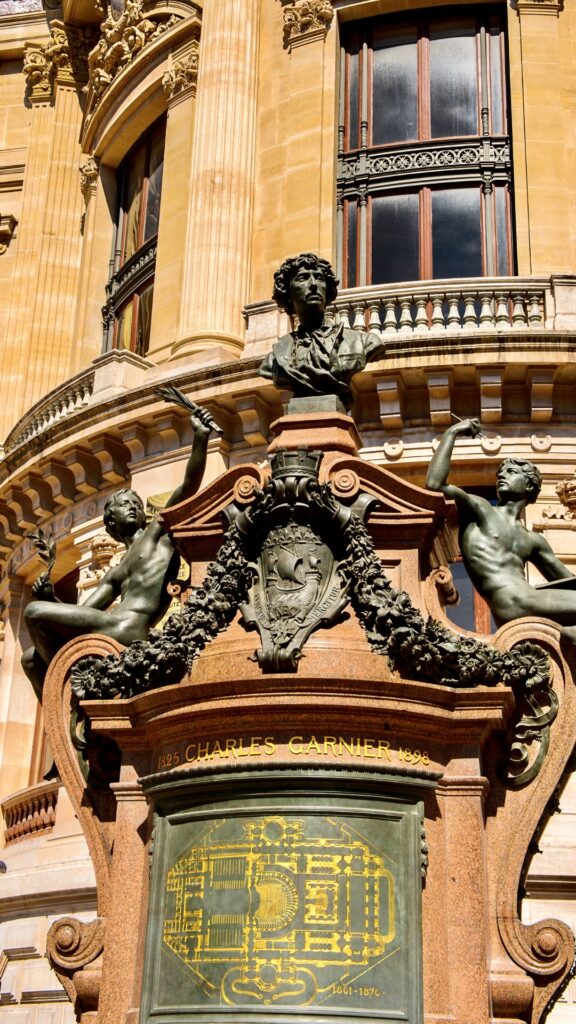
During construction, the opera facade was kept under wraps, to build tension. When the opera was finally inaugurated in 1875, the public saw the showy facade for the first time.
And they were stunned.
Tickets & Tours
The Opera Garnier is a popular attraction that you should book ahead. Click here to book a skip the line ticket. Click here to book a 2 hour guided tour.
Guide To The Opera Garnier: What To See
Here’s what you’ll see on a visit to the Opera Garnier.
Exterior Facade
The exterior is sometimes compared to a wedding cake. You can sort of see why.
It’s built in a rather bombastic Beaux-Artes style with eclectic Neo-Baroque elements. Between the grand columns are bronze busts of great composers. The two gilded figures crowning the facade on the left and right are Harmony and Poetry.
At the very top, there’s a statue of a shining Apollo holding up a lyre. He seems intent on proclaiming that the opera house is THE place for arts.
One the eastern side is the Emperor’s Pavilion, the only non-symmetrical part of the building. This was the entrance for Napoleon and wealthy season ticket holders. It’s now closed.
The most famous sculptural group on the facade is The Dance by Jean-Baptiste Carpeaux.
When it was unveiled in 1869, it caused an immediate furor because of its “obscene” nude figures. An anonymous vandal even threw black ink on the sculpture.
Carpeaux steadfastly refused to sculpt a substitute. But during the fall of the Second Empire, critics were distracted.
The sculpture was forgotten and never replaced. Now, there’s a replica on the opera facade and the original is in the Musée d’Orsay.
READ : Guide To the Masterpieces of the Musee d’Orsay
Paris Opera Interior
You enter on the left side and are greeted by a bust of Garnier.
The interior was designed in four segments: the entrance, the auditorium, the stage, and the administrative offices. As you proceed through, it’s almost a crescendo, with each room more magnificent than the next.
The acoustics were outstanding, and the stage one of Europe’s largest.
The highlights are the Grand Staircase, the Grand Foyer, and the Chagall Ceiling. You begin on the ground level and are greeted by costumes. The Opera Garnier makes all their own costumes, an impressive feat itself.
1. Grand Staircase, aka the Catwalk
Then you walk up the jaw dropping Grand Staircase. It’s made entirely of marble, and surrounded with arches, hidden nooks, statues, and gold — gold everywhere.
In the 19th century, the haughty Grand Staircase was a gossipy soap opera, the place to see and be seen.
Garnier aptly said that “The opera is the staircase.” The scandalous stairway revealed all — who was together, who was having affairs, who was favored, who was scorned.
The staircase is made of white marble from Italy, with balusters of antique red and green marble. The staircase is flanked by 36 large columns, and divides into two staircases that direct opera goers to their respective seats.
The ceiling has fresco by Isidore Pils, painted in 1869-74, that depicts the Triumph of Apollo. At the top of the staircases are large torchieres.
2. The Grand Foyer, a Mini Versailles Hall of Mirrors
The 18 foot high Grand Foyer is astonishing. It’s decidedly reminiscent of the Hall of Mirrors at Versailles.
This was the place where aristocrats strolled after they were done “acting” on the Grand Staircase or during intermission.
The room is all gold and glitter. At the top, is another impressive ceiling fresco, this one by Paul Baudry, which shows the history of music.
The foyer’s key decorative motif is the lyre. The Grand Foyer was renovated to perfection in 2004.
At each end of the grand foyer lie two salons. The Salon du Soleil (Sun Salon) has a golden sun burst and mirrored walls. The Salon de la Lune (Moon Salon) boasts a night sky adorned with silver moon rays and stars.
The sun room was supposed to represent fire and be the smoking room. The moon room was supposed to represent ice, for a cool sorbet.
But the decorator reversed the schemes to Garnier’s dismay. Opera goers were forced to traipse through the “ice room” to smoke a cigar and the “sun room” to nibble a sorbet.
3. Chagall Ceiling: A Surrealistic Gift to Paris
The Marc Chagall ceiling isn’t original. It was commissioned in 1964 and placed over the existing academic painting by Jules-Eugene Lenepveu, The Muses and the Hours of the Day and Night .
But it’s so much better. It’s the perfect backdrop for the Garnier-designed 7 ton bronze and crystal chandelier.
Legend holds that General de Gaulle and Andre Malraux, minister of culture, were attending an opera with a set and costumes designed by Chagall. The minister glanced at the ceiling and frowned in tedium. On the spot, he asked Chagall to design a new ceiling.
Chagall was a “modern” artist back then. His supernatural style work drew from the artistic movements of Surrealism, Fauvism, and Cubism.
The proposed ceiling was controversial. Some people don’t like anything new. Some thought it was garish and would clash with the opera’s Second Empire decor.
To keep the peace and as a concession to critics, Chagall proposed that Lenepveu’s work be preserved and Chagall’s be placed on a removable canvas stretched over it.
The mural took Chagall a year to complete. It consists of 12 canvas panels and a round central panel covering 240 square meters.
Chagall was 77 at the time and it was an act of love. He donated it to the opera house gratis. The mural has his trademark features — luminous prismatic colors, dreamy details, and poetic lyricism.
If you look closely, you’ll see that the ceiling is an homage to music. It features 14 composers from different musical periods, musical instruments, and Paris’ signature buildings.
Malraux is even hidden behind a window. Chagall’s ceiling helped make the opera more fashionable again.
4. Auditorium and Stage
Red is the color of glamor. And that’s what you’ll find in the opera auditorium.
If you want to actually visit the auditorium, you have to go on a guided tour. On the self-guided audio tour, you can only peek through a window and can’t properly see the Chagall ceiling.
The auditorium is very ornate, decorated in red velvet, marble, and gold leaf. Because you can never have enough gold leaf in an opera house. If you’re thinking that it’s just all too much, remember that opera itself a florid overwrought affair.
The stage is a classic horseshoe shape. The curtain is actually made of canvas, but contrived to appear like draping velvet. The stage featured many luminaries, including opera star Maris Callas and dancer Rudolf Nureyev.
The auditorium seats almost 2,000. While gorgeous, the seats don’t look terribly comfy. They were made in another era, where comfort didn’t dictate nearly everything.
The most expensive seats are the boudoir-like boxes, though they have a slightly obstructed view of the stage.
The point, of course, was to be seen by others, not to have the most ideal view of the performance. Or, to draw the velvet curtains for a tryst. The opera’s a romantic place, after all.
Phantom of the Opera: Inspired by the Opera Garnier
By today’s politically correct standards, with its clunky plot, Phantom of the Opera may seem a bit dated or patriarchal. But I can’t resist a lush high Gothic romance, even if the titular hero is a bit murdery. It’s escapism, as its author Gaston Leroux, a true crime writer and opera critic, no doubt intended.
Yet, the practical side of me always wonders where the Phantom got a horse and does he have a humidifier.
In any event, for purposes of this article, I want to explain how historical events at the Opera Garnier inspired Leroux’s 1910 potboiler. His fantasy novel is an ingenious blending of fact and fiction, with the Paris Opera as a star character.
The novel stars Erik as the phantom, a disfigured composer who wears a mask to cover his face. He takes up residence in the underground lake beneath the theater.
Erik becomes obsessed with a young soprano, Christine Daaé. He becomes her “angel of music,” giving her complimentary singing lessons.
The phantom rigs a chandelier to fall on the audience as a distraction, killing people. He then kidnaps Christine, taking her by gondola to his watery underground lair full of secret tunnels. He regales her with the title song Phantom of the Opera and Music of the Night.
Christine’s star rises, and a handsome suitor enters the picture. A jealous Phantom is furious and begins terrorizing the opera house. I won’t spoil the ending if you haven’t read the novel or seen the musical.
But many elements of Leroux’s novel, which is set in an opera house, come directly from the Paris Opera. The Phantom’s underground lake-lair is real, as I mentioned above. Though today it’s brightly lit, so not as eerily gloomy. And there are actually tunnels, just as Leroux wrote.
The Paris Opera chandelier is also featured in Leroux’s novel. In 1896, a counterweight fell from the real chandelier, killing a woman in the audience. In Phantom, Leroux also uses a falling chandelier as a major plot point, a dramatic scene (described above) of kidnapping and senseless murder.
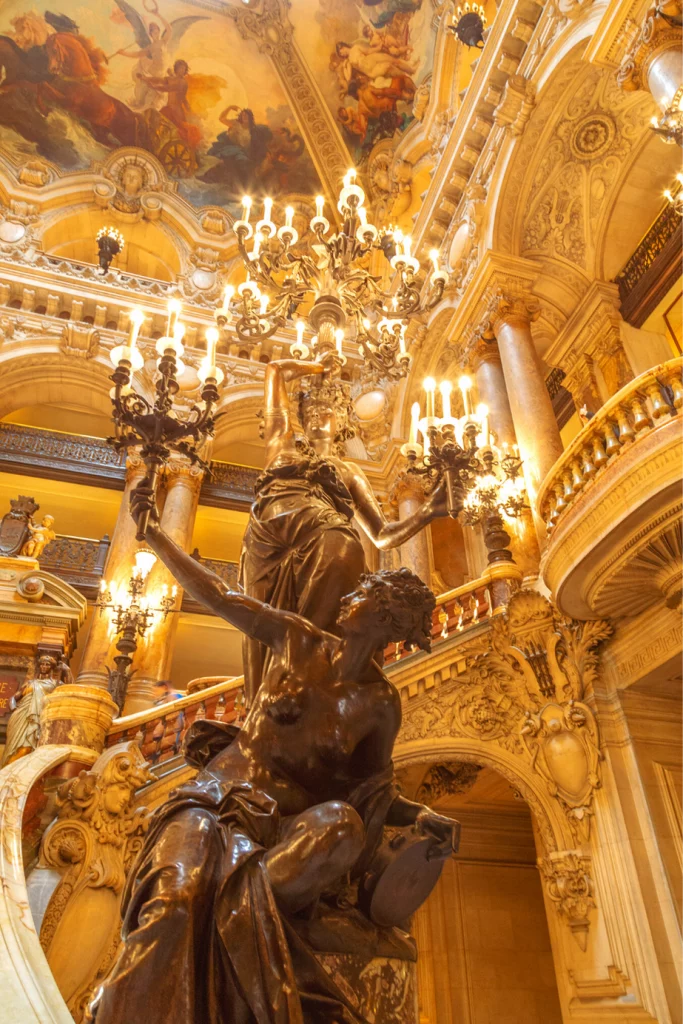
When Leroux wrote his novel, people also really thought that a pesky ghost was haunting the Paris Opera, just like the phantom haunts the opera in the novel and musical.
Paris Opera performers hung a lucky horseshoe by the stage to ward off evil spirits. Some claimed to hear ghostly whispers from Box #5, even when it was vacant.
Although the Christine-Phantom romance is fantasy, the characters of Erik and Christine may be based on actual people.
The grand masked ball they attend was set on the Paris Opera’s Grand Staircase. The Phantom appears on the staircase dressed as Red Death, carrying a copy of his new opera. His opera is then performed on a stage much like the Paris Opera stage.
Tips For Attending a Performance at the Opera Garnier
The Opera Garnier still functions as a world class performance venue. It’s the home of the Paris Ballet. So usually ballet is on the menu, but there are also concerts and operas.
You can check the schedule of performances here .
Just click on the calendar to see what’s playing that month. Click on Garnier, not Bastille. The new Opera Bastille utterly lacks the Garnier’s old world ambiance anyway.
It’s easiest to reserve online. You need to register on the website to book a ticket. Choose your seats. And voila!
Attire is mostly business-y or business casual, which makes sense because people are going to the opera house after work. You won’t need a fancy ballgown, unless you’re going to a special evening gala.
Like most US theaters, there’s a bar inside that sells champagne and snacks before the show and during intermission.
Arrive early to admire the gorgeous building and take photos on the iconic marble stairway. If the performance isn’t in English, there will be subtitles.
But don’t let the subtitles distract you from gazing, in adoration, at the sublime Chagall ceiling. If you’re not close enough, head to the orchestra section during intermission to take in the colorful centerpiece.
Don’t miss the glorious Opera Garnier. It’s an unmissable Paris site and one of the best things to do in the 9th arrondissement.
Swathed in gold, you can strain your ears to hear echos of the Phantom of the Opera. You won’t be kidnapped or killed. But you can visit the haunts that inspired the novel and bask in Garnier’s grandiose creation.
Practical Guide & Tips for Visiting the Opera Garnier:
Address: 8 Rue de Scribe, Place de l’Opera 75009 Paris
Hours: 10:00 am to 4:30 pm, Guide tours in English are at 11:00 am and 2:30 pm
Entry fee: 14 euros for a self guided tour. Not included in Paris Museum Pass.
Metro : Line 3, 7, or 8 to Opera
Pro tips: The nearest car park is Place Vendome. Access to the auditorium may be closed for technical reasons or performance rehearsals.
Virtual Tour : If you can’t get to Paris, you can explore the Opera Garnier virtually on Google Arts & Culture .
I hope you’ve enjoyed my guide to the Opera Garnier. You may enjoy these other travel guides and resources for Paris:
- 5 Day Itinerary for Paris
- 3 Day Itinerary for Paris
- 2 Day Itinerary for Paris
- One Day In Paris Itineraries
- Tips for Planning a Trip to Paris
- Tourist Traps To Avoid In Paris
- Top Attractions in Montmartre
- Top Attractions in the Latin Quarter
- Top Attractions in the Marais
- Best Museums In Paris
- Hidden Gems in Paris
- Secret day trips from Paris
If you like to visit the Opera Garnier in Paris, pin it for later.
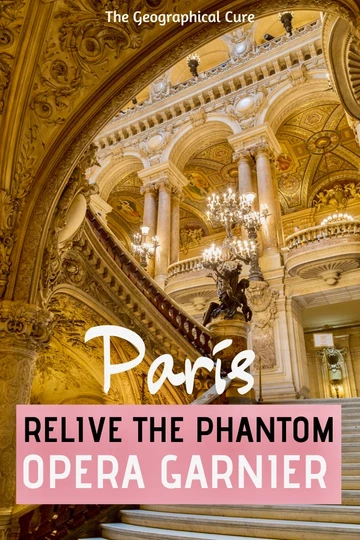
1 thought on “Guide to Paris’ Opera Garnier: Inside the Phantom’s Lair”
Very interesting many thanks for this, I would love to visit
Leave a Comment Cancel reply
Save my name, email, and website in this browser for the next time I comment.
Last Updated on January 29, 2023 by Leslie Livingston
- Today's deals
- Search travel guides

Paris Opera House – Take A Self-Guided Tour of Palais Garnier
If you’re planning a trip to Paris , you’ll want to design an itinerary that includes some cultural highlights like the renowned Palais Garnier , the premier Paris opera house that’s located in the 9th Arrondissement on the Boulevard des Capucines. Completed in 1875, the Palais Garnier is one of the world’s most celebrated cultural attractions. Filled with great art and opulent architectural details, the Paris Opera Garnier also boasts revered productions of opera, ballet, and classical music performances and features a seating capacity of 1,900.
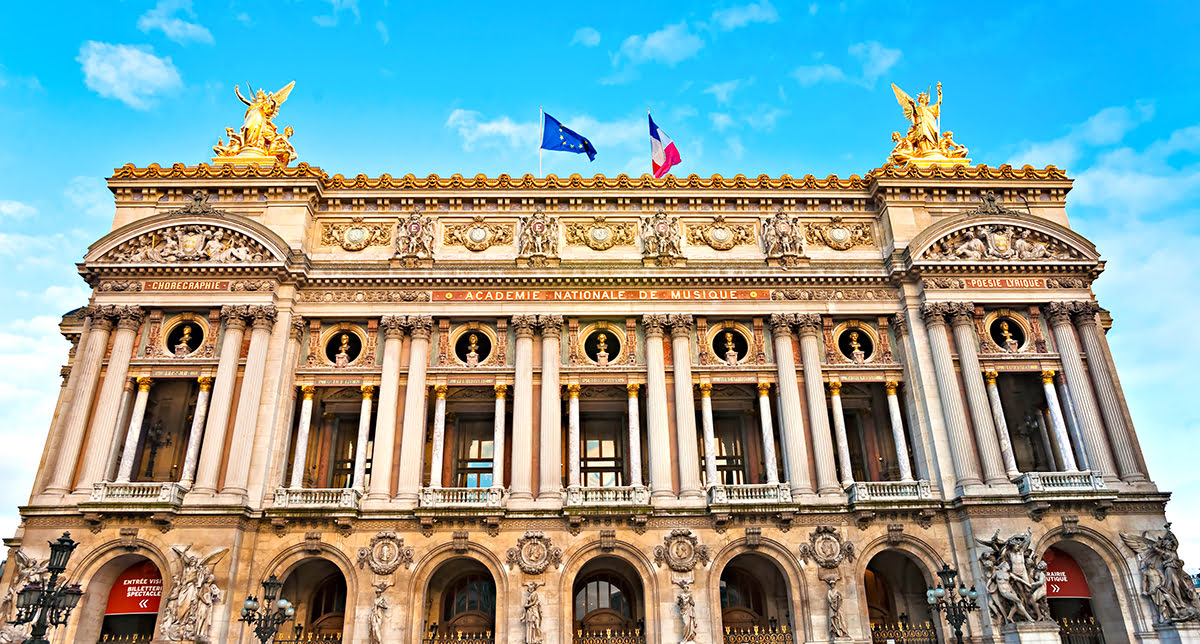
Introduction to the Paris Opera
A Parisian architectural jewel, the Palais Garnier is an example of Napoleon III architectural style, which ornately combines elements of the Renaissance and Baroque styles. Designed by architect Charles Garnier, the Palais Garnier Paris was constructed between 1861 and 1875. At the time of its opening, the Palais Garnier-Opera featured the largest theater and opera house in the world. While its exterior is well-known for its rooftop statuary, its interior is filled with frescoes, mosaics, and gilt and marble-covered decorations.
Before exploring the Palais Garnier on your own or with a guided tour, it’s helpful to get to know some of its history. The Paris Opera Garnier is, of course, the famous setting for the 1910 novel by Gaston Leroux, The Phantom of the Opera. The novel and its various film and stage adaptations, particularly the 1986 musical, attract many visitors to the fabled Paris opera house. During tours of the Palais Garnier, tour guides will touch on some of the novel’s highlights that correspond with features of the opera house like its seven-ton bronze chandelier.
- Highlights of Paris’s Opera Garnier include its white marble Grand Staircase, the Paris Opera Library Museum, the main exterior façade that faces the Place de l’Opera (and includes its famous sculptures), the gold-leaf and chandelier-strewn Grand Foyer, and the decadent Italian-style Auditorium.
- The auditorium stage of the Palais Garnier can accommodate more than 400 performers.
- During a visit to the Palais Garnier Opera , admirers of art will want to take in the opera’s prestigious artworks created by illustrious artists such as Marc Chagall, Charles Gumery, Aime Millet, and Paul-Jacques-Aimé Baudry.
- Today, the Garnier Opera also features a restaurant, the L’Opera Restaurant that is open to the general public along with guests of the opera and ballet.
- Anyone interested in the Paris Opera’s history should spend some time visiting the Paris Opera Library-Museum, known as the Bibliotheque-Musee de l’Opera de Paris. This museum features a wealth of historic Palais Garnier memorabilia such as opera posters and artifact associated with the Palais and its various renowned productions and performances. The museum is open daily and does not charge for access. Some of the highlights of the Palais Garnier’s museum are the costume displays, autographs, drawings, scale models of set designs, and paintings.
The Palais Garnier is located in the 9th Arrondissement on the Right Bank of the Seine in the area of the city known as “The Opera District.”
The Palais Garnier is open every day (with some exceptional closures) from 10 AM – 4:30 PM. Tickets for the Opera Palais Garnier list performance times. The L’Opera Restaurant remains open when the Garnier Opera is closed.
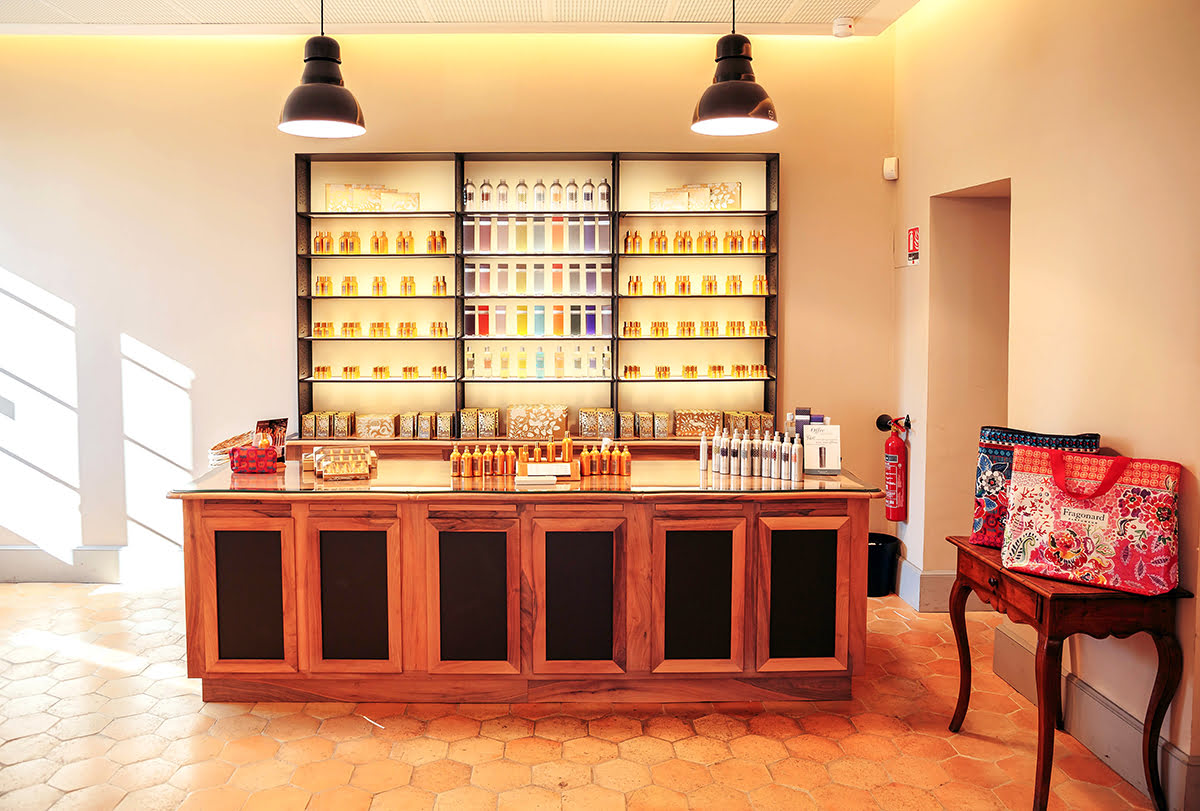
Shopping & Things to Do near the Paris Opera
The area surrounding the Paris Palais Garnier is filled with cultural and historical attractions. After touring the Garnier Opera, visitors may wish to attend the illustrious department stores of the Opera District – Printemps and Galleries Lafayette. Must-see attractions in the area of the Palais Garnier include the Musee du Parfum, Musee Grevin, and Folies Bergere. Other attractions within a 20-minute taxi drive of the Opera Palais include the Bastille Opera, La Defense, Latin Quarter , St. Germain, Tuileries Gardens, and the Japanese neighborhood near Rue Sainte Anne .

Best Places to Eat near the Paris Opera
Whether you’re attending a performance at the illustrious Opera Garnier or attending one of its day tours, you may wish to visit one of the area’s well-known restaurants. Naturally, the L’Opera Restaurant located at the Opera Palais Garnier attracts many opera goers, but there are many other restaurants and cafes located in the Opera District that cater to many different tastes. Many of the area’s restaurants also double as popular nightlife spots due to their late hours.
Upscale Restaurants
- Café de la Paix
- Le Grand Café Capucines
- La Verriere Restaurant
- Opera Mandarin
- Maison de la Truffe
Mid-Range Restaurants
- 16 Haussmann
- Royal Madeleine
- Restaurant Le Maroc
- Bollynan Montorgueil
- Restaurant le Celadon
Budget-Friendly Restaurants
- Villa Victorian
- Brioche Doree
- Maison Verot

Nightlife near Palais Garnier
The Opera Palais Garnier is itself the area’s leading nightlife attraction. However, there are attractions and clubs in the region that promise multiple types of nightlife. From savvy clubs to low-key lounges, the Opera District boasts a dazzling array of nightlife options for visitors to Paris.
- Le Grand Bar de l’Hotel Intercontinental
- Le Bar a Bulles
- Bar Hemingway (Located at the Ritz Paris)
- Harry’s Bar
- Paris Bodega
- Little Red Door
- Les Alchimistes
- Les Ambassadeurs
- Marlusee et Lapin
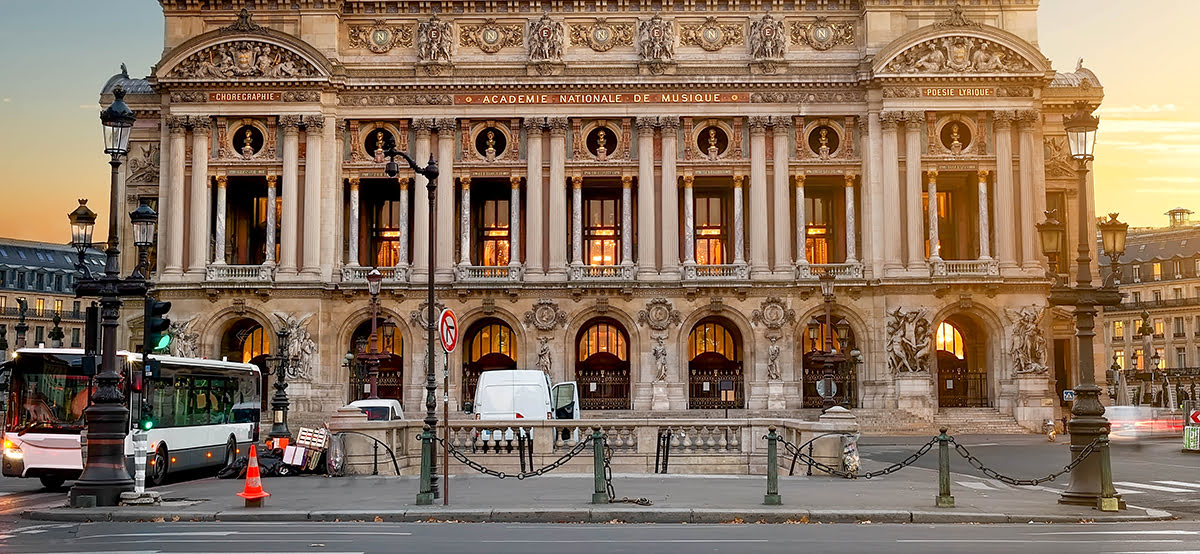
Transportation at Palais Garnier
If you’re traveling to the Paris Opera Garnier from the Gare de Lyon , you’ll have multiple options for transportation. Since there is a Metro stop just in front of the Palais Garnier Opera, you may wish to use the 3, 7, or 8 lines. If you’re taking a taxi from the Gare de Lyon, expect about a fifteen-minute drive.
Bus lines that travel to the Palais Garnier include: 20, 21, 22, 27, 29, 42, 52, 53, 66, 6 8, 81, 95. As a major tourist destination, the Paris Opera Garnier is easily accessed from nearly any part of the city using public transportation. The nearest car park for drivers to the Paris Opera is at the Place Vendome .
Once in the neighborhood of the Palais Garnier, visitors often find that many popular nearby attractions are within easy walking distance. Additionally, there are popular walking tours of the Opera District .
Where to stay near Paris Opera
The area of the Palais Garnier features everything from upscale historic hotels to cheap hotels in convenient locations near Metro stops. Because there are numerous hotels in the Opera District, you’re sure to find one that can accommodate your travel needs.
Check in to a Hotel or Apartment near Galeries Lafayette Maison
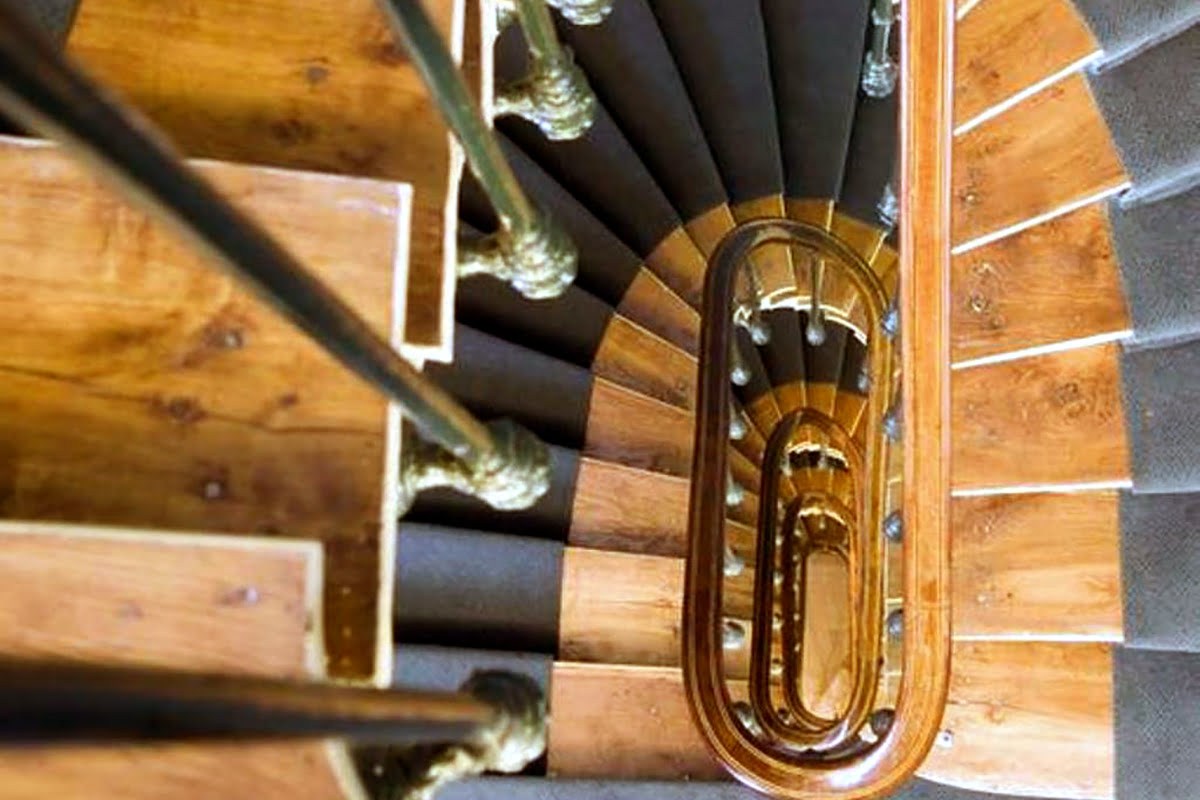
You may also like

Welcome to Your 7-Day Dream Itinerary in Krabi

Embark on a Weekend Getaway to Yilan: A Quick Escape into Nature
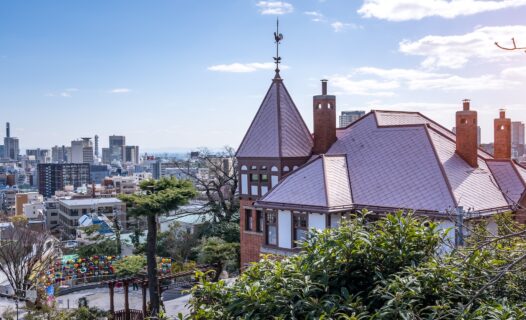
Welcome to Kobe: A Gateway to Discovery and Delight
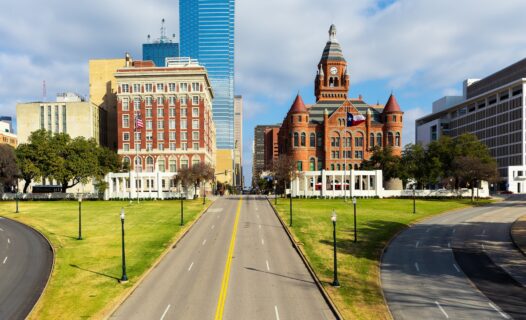
3 Days in Dallas Itinerary: Must-Visit Attractions and Hidden Gems

Hat Yai: A 5-Day Itinerary to Southern Thailand's Hidden Gem

Adventure Seeker's Nha Trang Itinerary: A Thrilling 5 Day Guide

3 Days in Macau Itinerary: A Guide to Exploring The Las Vegas of Asia

A Food Lover's 3-Day Guide to Ipoh: Best Eats and Culinary Adventures Itinerary

Weekend Getaway in Orlando Itinerary: Top Attractions & Hidden Gems
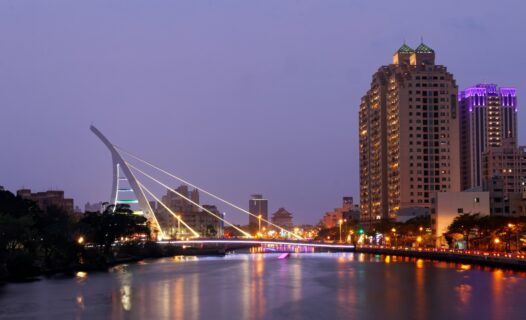
Discovering Tainan: A 3-Day Itinerary of History, Culture, and Culinary Delights

7 Days in New York City Itinerary
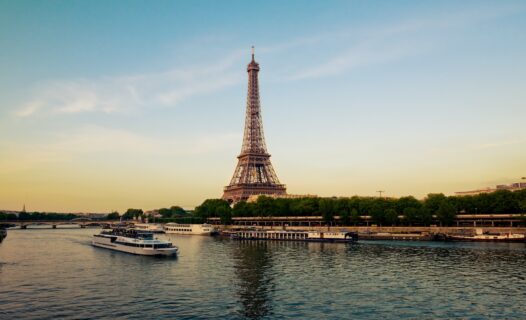
7 Days in Paris Itinerary: Exploring the City of Lights
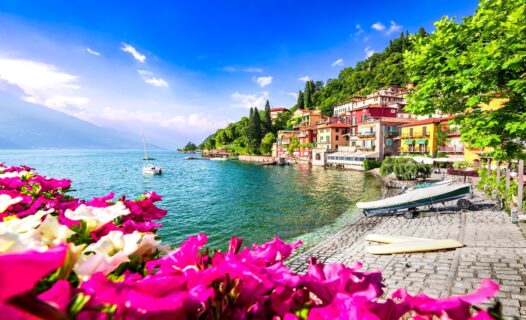
Magical Mother's Day Getaways: Top Italian Retreats for 2024

Goa Sightseeing Itinerary: Exploring the Pearl of the Orient

A Gourmet Journey through France for Mother's Day 2024: The Ultimate Culinary Experience
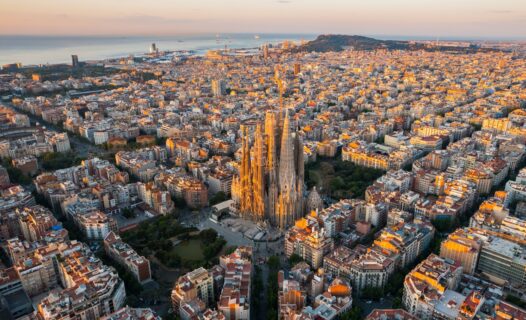
An Unforgettable Mother's Day Celebration in Spain 2024

Celebrating Mother's Day 2024 in Canada: A Travel Guide to Making It Special

Embark on a Scenic Train Journey: Celebrating Mother's Day 2024 Across America's Rails
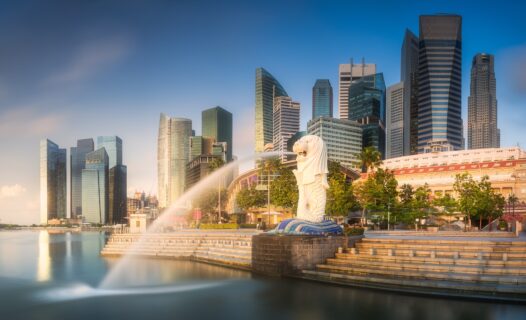
Celebrating Mother's Day 2024 with Unique Cultural Experiences in Singapore

Ultimate Guide to Mother's Day 2024 in Hong Kong: Celebrations Across the City

A Mother's Day to Remember: Celebrating in Jaipur's Embrace

Dive into our exclusive 7-Day Krabi Itinerary on Agoda’s Travel Guide. Discover pristine beaches, lush jungles, and cultural treasures in Thailand's paradise.

Embark on an extraordinary weekend getaway in Yilan with our curated itinerary. Discover lush landscapes, soak in natural hot springs, and indulge in local culinary delights.

Embark on a captivating 3-day journey through Kobe, Japan. From historical landmarks to scenic beauty, discover the best of Kobe.

Uncover the best of Dallas with our exclusive 3-day itinerary. From iconic landmarks to hidden gems, discover why Dallas, TX, is a must-visit destination.

Hat Yai: A 5-Day Itinerary to Southern Thailand's Hidden Gem
Discover the best of Hat Yai with our 5-day itinerary. From bustling markets to serene temples, experience the hidden gems of Southern Thailand.

Adventure Seeker's Nha Trang Itinerary: A Thrilling 5 Day Guide
Dive into our 5-day Nha Trang itinerary designed for adventure seekers! From island-hopping to scuba diving and cultural wonders, discover the best of Nha Trang with our expert guide.

Dive into our engaging 3-Day Macau Itinerary to uncover the vibrant mix of history, culture, and exhilaration in Asia's Vegas.

A Food Lover's 3-Day Guide to Ipoh: Best Eats and Culinary Adventures Itinerary
Dive into Ipoh's culinary paradise with our 3-day food lover's guide! Discover the best eats, hidden cafes, and cultural delights in Malaysia's gastronomic haven.

Weekend Getaway in Orlando Itinerary: Top Attractions & Hidden Gems
Unveil the magic of Orlando with our exclusive weekend getaway itinerary! From thrilling theme parks to serene gardens and vibrant nightlife, discover top attractions and local hidden gems.

Explore Tainan in 3 days with our in-depth itinerary. Discover ancient temples, savor local culinary delights, and unwind in serene natural spots.

Embark on a 7-day unforgettable journey through New York City. From the iconic streets of Manhattan to the serene Hudson Valley, discover the Big Apple's top attractions, hidden gems, and vibrant culture.

Discover the ultimate 7 days in Paris itinerary! Explore iconic landmarks, savor French cuisine, and immerse in art and history.

Magical Mother's Day Getaways: Top Italian Retreats for 2024
Discover the most enchanting retreats in Italy for celebrating Mother's Day 2024. From luxurious spa resorts to charming Italian villas, find the perfect getaway to honor the special women in your life.

Embark on an unforgettable journey with our Goa Sightseeing Itinerary. Explore sun-kissed beaches, vibrant nightlife, serene temples, and lush wildlife.

A Gourmet Journey through France for Mother's Day 2024: The Ultimate Culinary Experience
Embark on a gourmet journey through France to celebrate Mother's Day 2024 with exquisite culinary experiences, from Paris to Provence.

An Unforgettable Mother's Day Celebration in Spain 2024
Discover the perfect way to celebrate Mother's Day 2024 in Spain. From cultural treasures in Barcelona to sun-kissed moments in Madrid, make Mother's Day unforgettable.

Celebrating Mother's Day 2024 in Canada: A Travel Guide to Making It Special
Discover the ultimate guide to celebrating Mother's Day 2024 in Canada. From serene retreats to cultural escapades, this travel guide covers all you need for a memorable Mother's Day.

Embark on a Scenic Train Journey: Celebrating Mother's Day 2024 Across America's Rails
Embark on an unforgettable Mother's Day journey with our guide to the most scenic train rides across the USA. From rolling mountains to historic routes, treat your mom to breathtaking vistas and cherished memories.

Celebrating Mother's Day 2024 with Unique Cultural Experiences in Singapore
Celebrate Mother's Day 2024 in Singapore with a guide to luxurious staycations, cultural events, and unique experiences. Make it unforgettable for the special woman in your life.

Ultimate Guide to Mother's Day 2024 in Hong Kong: Celebrations Across the City
Discover the ultimate guide to celebrating Mother's Day 2024 in Hong Kong. From luxurious spa retreats and cultural explorations to vibrant markets and panoramic photography spots, find everything you need to plan an unforgettable day for the special woman in your life.

A Mother's Day to Remember: Celebrating in Jaipur's Embrace
Discover the ultimate guide to celebrating Mother's Day 2024 in Jaipur. From luxurious stays to cultural explorations and culinary delights, create unforgettable memories with your mother in the heart of Rajasthan.
Current language
All languages.

- Paris by night Paris by night
- Versailles Versailles
- Giverny Giverny
- France France
- Day trips from Paris Day trips from Paris
- Fooding Fooding
- Cruises Cruises
- Find your order
- Our Sanitary Program
- +33 (0)1 44 55 60 00
Choose a place
The Phantom of the Opera : from book to movie(s)
Written by Gaston Leroux and first published in 1910, The Phantom of the Opera is a fantasy novel whose action takes places primarily in the Palais Garnier. The extremely popular book has been adapted several times and is even partially responsible for the success of this legendary Parisian venue.
The story of the Phantom of the Opera
There are no restful days at the Palais Garnier, between rehearsals and performances. Then tragic events start occurring, causing some to suggest that the place is haunted: a chandelier crashes down, a stage hand is found hanged under troubling circumstances... Eventually the more sordid truth comes out: the management of the Palais Garnier is ordered to pay 20,000 Francs per month to put an end to the drama. Who is behind the blackmailing? None other than the Phantom of the Opera.
But the mysterious phantom's plans are thrown up in the air with the arrival of Christine Daaé, an orphaned singer. The love he feels for the young woman could disrupt everything and undermine all his plans. The Vicomte Raoul de Chagny, who is also desperately in love with Christine Daaé, refuses to let the phantom win the heart and hand of his beautiful chanteuse .
The many adaptations of Phantom
The book has been adapted many times. Over the years, a play, some 20 musicals, a ballet, several films and TV movies have all revisited the legendary work of Gaston Leroux.
The most notable cinematic interpretation is the feature by director Joel Schumacher released in France in 2005 with the straightforward title "The Phantom of the Opera", starring Gerard Butler ("300", "P.S. I Love You") Emmy Rossum ("Shameless", "The Day After Tomorrow").
Many musicians have also embraced the story and written songs inspired by the legend, usually in English under the title "Phantom of the Opera".From lyrical opera to heavy metal, every style has its version.
Meanwhile comics and web series continue to stoke the myth.
Follow in the footsteps of the Phantom of the Opéra Garnier
When you take a guided tour of the Opéra Garnier , you can explore some of the nooks and crannies of this legendary building, straining your ear to hear the echo of the phantom of the opera. This is where fact meets fiction: while the Palais Garnier does not harbor a vast underground maze, its halls and wings do form a fascinating labyrinth that will whisk you away to another world: this is the world of classic dance and lyrical music, of talent and artistic sensibilities that light up the eyes and the soul.
We wish you a most pleasant tour . And if you happen upon the phantom of the opera around a corner, don't fret. There is little chance he will drag you into his underground lair.
If you like unexpected, hidden spots, pair your tour of the Palais Garnier with an introduction to the covered passages of Paris.
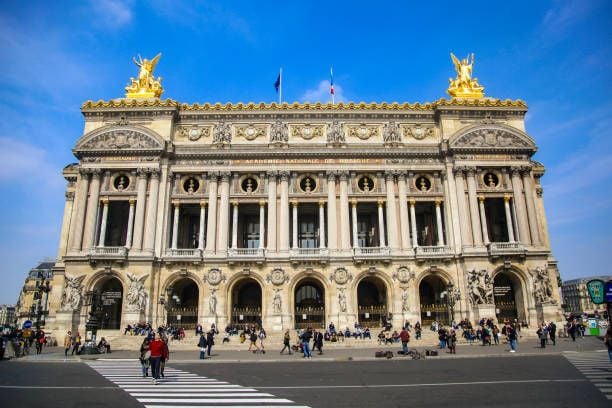

Is the Palais Garnier Opera House Paris Worth Visiting? (2023)
Considering visiting the Palais Garnier? It’s no secret that Paris is full of an abundance of world-renowned landmarks. However, if you have a short amount of time in the city, you may be overwhelmed trying to plan the perfect itinerary and wondering is the Palais Garnier is worth visiting.
In this article, I will share my personal experience, provide insights into what you can anticipate, and hopefully help you decide whether or not to visit the Opera Garnier!
Table of Contents
Is the palais garnier worth visiting (2023), palais garnier tours & tickets, best time to visit the palais garnier, 7 interesting palais garnier facts, where to stay in paris, palais garnier: faq, wrap-up: is the palais garnier worth visiting (2023).
The Palais Garnier or Paris Opera House, is the largest Opera House in Europe. And after exploring the captivating halls of the Opera Garnier, I wholeheartedly believe that this iconic landmark is an absolute must-visit for any traveler. Think of it like the Louvre or Eiffel Tower. Everyone visits even if they have no true interest in learning about the history or seeing specific works of art. In this sense, everyone should visit even if they aren’t the biggest performing arts enthusiast.
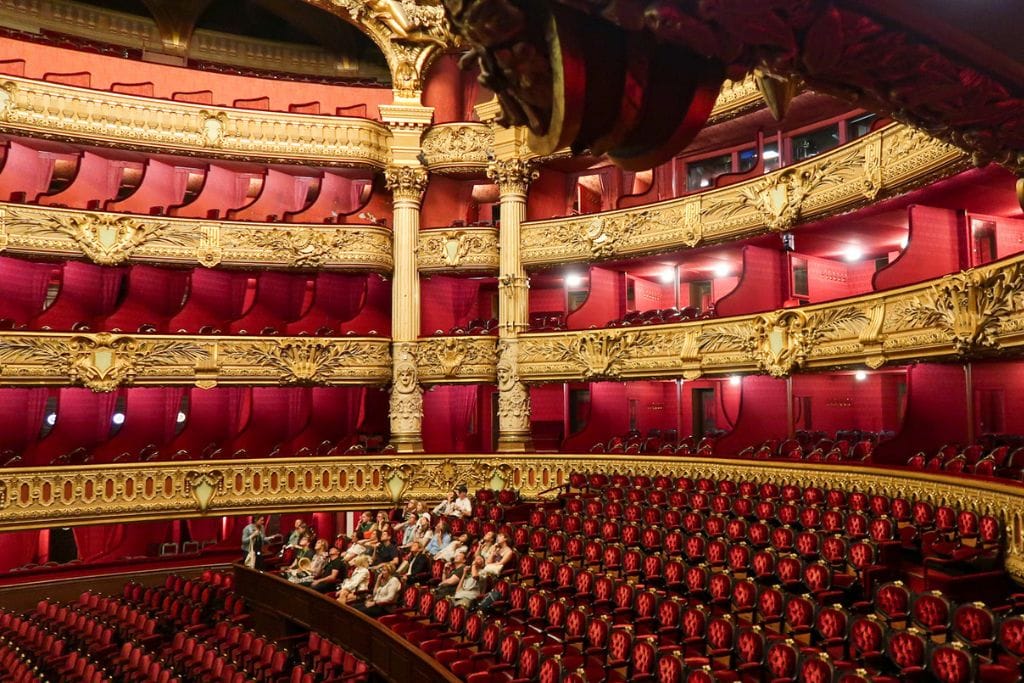
That said, I know that visiting the Opera House in Paris may genuinely not be worth it for some people lol. So below, you’ll find a few cases in which I think Palais Garnier is worth visiting and a few cases in which you may want to skip it.
The Palais Garnier Is Worth Visiting If…
You want to discover one of the most beautiful buildings in all of Paris. I know that was a very subjective statement to make, but as I said earlier, this is a building that should be seen by everyone. From the mesmerizing grand staircase adorned with marble and gold to the majestic auditorium with its exquisite chandelier and velvet red seats, every corner of the Opera Garnier exudes a sense of grandiosity and artistry that is truly unparalleled. Not only that, but the building serves as a living testament to the Parisian culture and its enduring love affair with the arts. There are so many hidden secrets and stories entrenched in the walls of Palais Garnier. It provides visitors an opportunity to connect to an era full of grandeur, elegance, and extravagance.
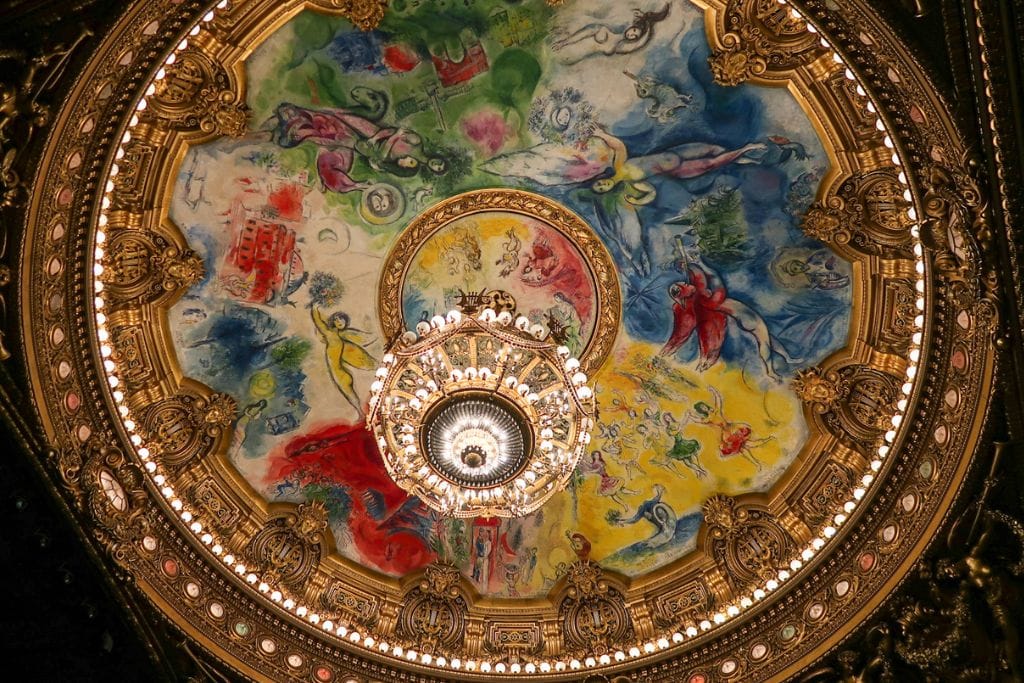
Lastly, I recommend visiting for anyone who loves the Phantom of the Opera. Personally, the Phantom of the Opera is one of my favorite stories ever. As a result, coming to Palais Garnier and getting to see the Phantom’s box and hear about pieces that inspired the story was an incredible experience. Thus, if you are a history aficionado, an architecture enthusiast, a lover of the performing arts, or a fan of the Phantom of the Opera, then the legendary Palais Garnier is likely worth visiting!
The Palais Garnier Is Not Worth Visiting If…
Honestly, there’s almost no scenario in which I wouldn’t recommend visiting the Palais Garnier. 😂 Like to me, it was that impressive… That said, if you have zero interest in admiring the architecture and the performing arts, then yeah it may be worth skipping. The entire duration of your visit, you’ll be walking around the areas open to the public, observing the architecture, and imagining what it must have been like to attend a performance centuries ago. Or, if you go on a tour, you’ll be doing that and listening to your guide speak about the history and origins of the building. 😅 So, if that doesn’t sound appealing, then it may be worth skipping.

Another case in which you may want to skip it is if you’re short on time. Obviously, this applies to every attraction in Paris. But, for those who really are passionate about the performing arts and keen on fully exploring this wonderful building, I highly recommend taking a tour. The only thing is that there are very limited spots for the tours. Therefore, if you can’t secure a spot on a tour and your only option is for a general entry ticket , I would maybe hold off until your next visit to Paris. That’s what I did because I wanted to discover the Palais Garnier all at once. Again, these are just my opinions. Take everything with a heap of salt!
Is the Palais Garnier Free? Unfortunately, Palais Garnier is not free to enter. You can either purchase a general entrance ticket and opt to complete a self-guided tour, or you can take a guided tour through Palais Garnier. Below are different ticket options you can select from.
- A regular entry ticket for a self-guided tour of Palais Garnier
- A bundled ticket: entry to Palais Garnier plus 1-hour cruise on the Seine
- Private 2-hour tour explores the Opera House & Galeries-Lafayette
- Guided large group tour run by the Opera House
For those who opt to do a self-guided visit, the best time to visit the Palais Garnier is during the week, right when the Paris Opera House opens at 10 AM. This is when you’ll have the best chance of avoiding crowds and having a slightly more intimate experience.
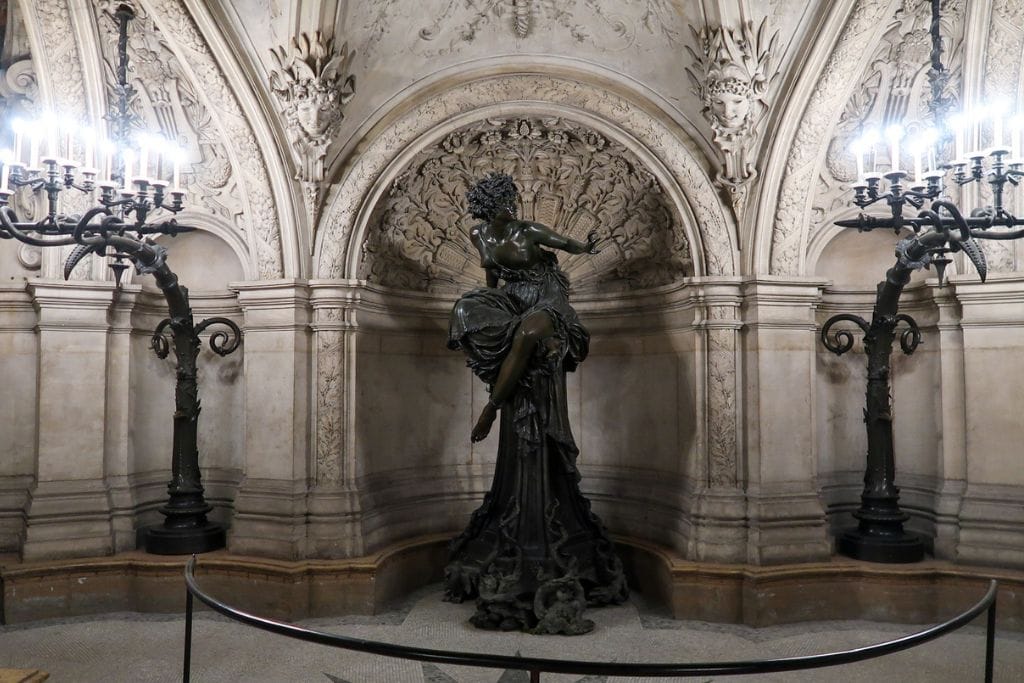
Oh and please note: Despite the website saying that the last entry time is 4:45 PM, I highly suggest not showing up any later than 4:30 PM. When I visited, they turned people with a general entry ticket away before 4:45 PM and told them to come back the next day. Meanwhile, for those who go with a guided tour, I highly recommend reserving an after-hours tour! Getting to explore Palais Garnier when it’s mostly empty and there’s a small fraction of the number of people who are there during the day is an absolute delight! Also, it does wonders for actually hearing what your guide has to say haha!
🎭 PRO TIP: If you opt to do a tour offered by the Opera House, reserve your tickets ASAP! They almost ALWAYS sell out well in advance! I was extremely lucky to find a tour for 4 days later because when I booked, they were almost completely sold out for the next two weeks!
How Long Does It Take to Walk Through Palais Garnier?
With a guided tour, it can take anywhere from 1 – 1.5 hours to walk through Palais Garnier, depending on the tour you select. If you opt to do a self-guided tour, you can obviously spend as much or as little time as you’d like. The optional audioguide that’s available as an add-on lasts 1.5 hours. So to be on the safe side, I’d plan on two hours! But you can of course rush through in about 45 minutes if you had to.
For those who want a sneak peek of what you may learn on a guided tour or are simply keen on learning a bit of background information on the history of Palais Garnier… here are 7 interesting Palais Garnier Facts!
1. Why Was the Palais Garnier Built?
Before the Palais Garnier was built, the Opéra de Paris resided in a temporary building known as the Salle Le Peletier. Aside from the location already being temporary, this location proved to have another monumental flaw that was exposed in 1858.
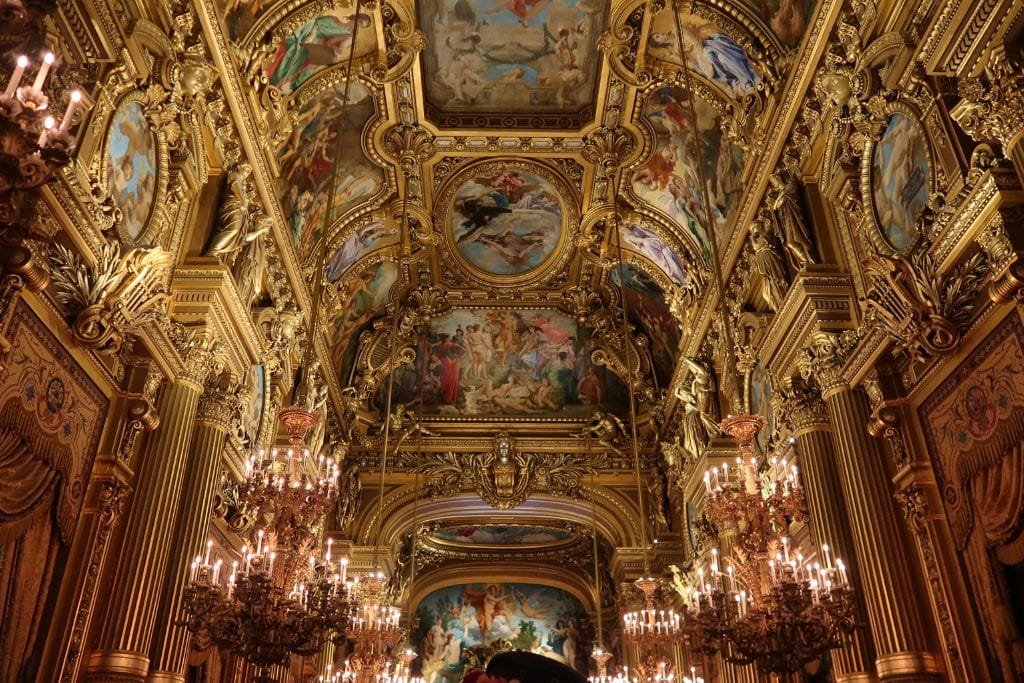
During a visit to the Salle Le Peletier for a concert, Napoleon III and Empress Eugènie narrowly escaped an assassination attempt. Three bombs exploded, causing chaos and resulting in the loss of eight lives. This event provided urgency to construct a new opera house in a more secure and spacious location that would allow for a private entrance for the head of the state.
Thus it was an assassination attempt combined with the inadequate facilities of the previous building that prompted the Palais Garnier to be built.
2. Palais Garnier Architect
While many people know of the Opera House in Paris, the name Charles Garnier, the architect, is lesser-known. This is because Garnier was essentially the equivalent of being plucked from obscurity. Let me explain. In December of 1860, Emperor Napoleon III officially announced an architectural design competition for the design of the new opera house. Over 170 proposals were submitted, with several world-renowned architects vying for the opportunity to design the new Paris Opera House.
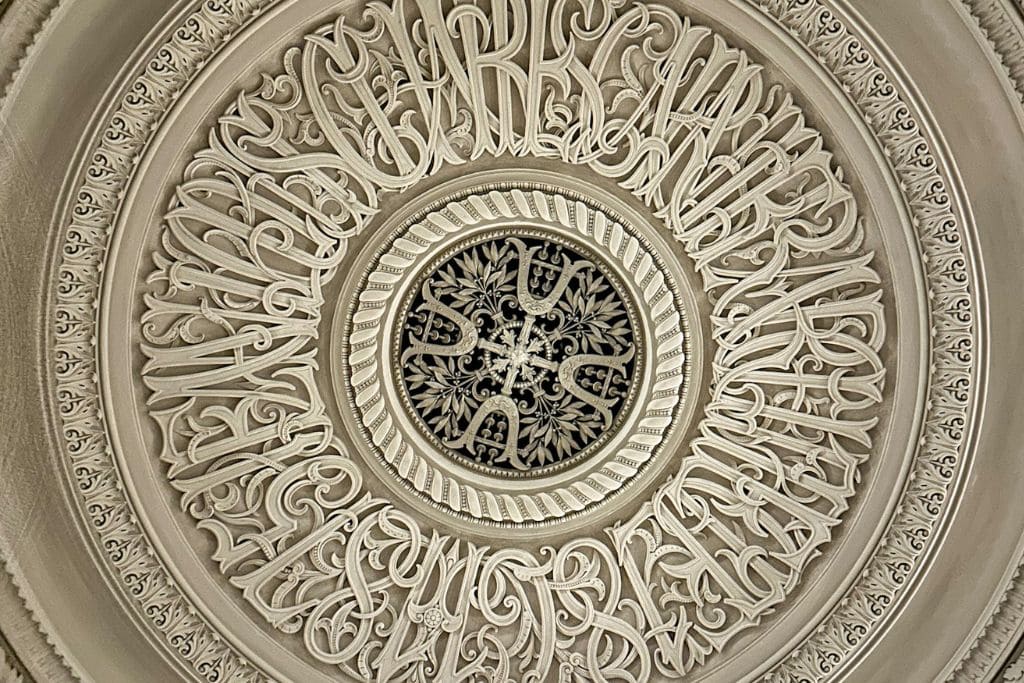
Despite the stiff competition, Charles Garnier found himself ranked last among the five finalists that would move on to the second part of the competition. And it was during the second half of the competition that Garnier found himself as the final contender in the competition. This was because he decided to take a bold approach, transforming his plans into a grandiose structure that deviated from strict classical conventions, adopting a more eclectic and expressive style. Other works by Garnier include the Nice Observatory in lovely Nice, France , and the Opéra de Monte-Carlo, which is part of Monaco ‘s famed casino.
3. Palais Garnier Architecture
The Palais Garnier was designed in what Garnier referred to as the “Napoleon III” style. This architectural style embraced eclecticism, drawing inspiration from various historical periods. As such, you can observe a harmonious blend of Baroque, Palladian classicism, and Renaissance elements.
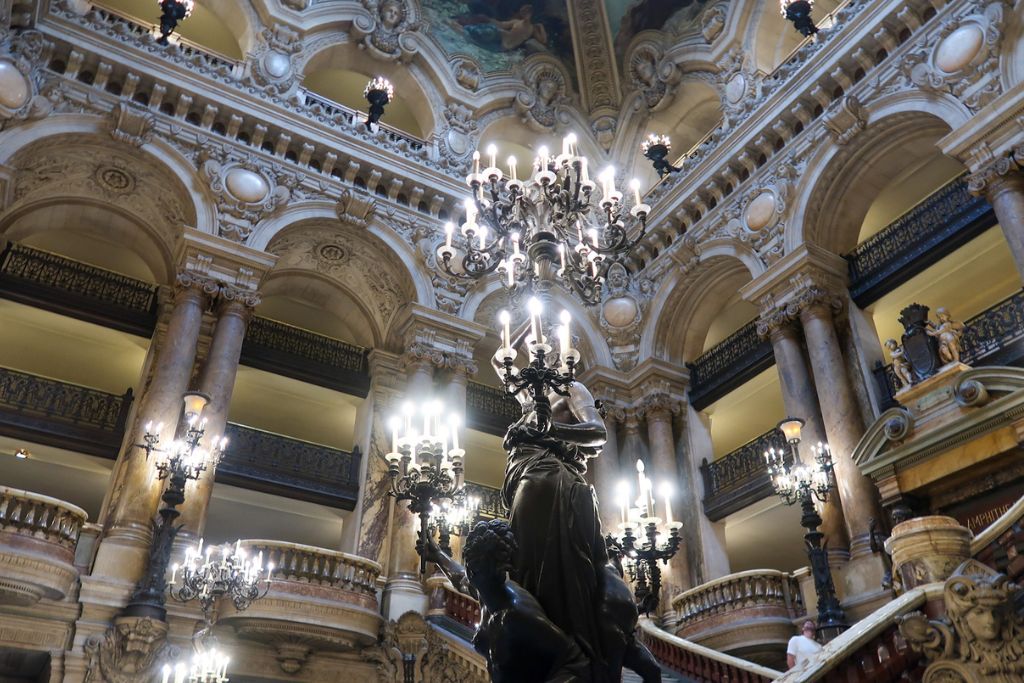
In addition, throughout the Palais Garnier, you’ll find lots of hidden details and symbolic elements. For instance, symbolism in the form of chords and lyres can be found in various parts of the opera house…
And near the entrance, you can find Charles Garnier’s name, profession, and the year the Opera House was completed discreetly inscribed on the ceiling!
From its intricate detailing to the subtle symbolism woven into its design, the opera house is a treasure trove of architectural wonders and hidden delights!
4. Grand Staircase Palais Garnier
Arguably the most well-known image of the Opera House in Paris of the Grand Staircase.
Crafted from exquisite white marble and adorned with a striking balustrade of red and green marble, the staircase splits into two divergent flights that gracefully lead to the Grand Foyer.

Above, you’ll see intricate and vivid paintings by Isidore Pils. A little fun fact is that the initial paintings were deemed too dark for the space just two months before the grand opening. As such, Pils and his students undertook the challenging task of reworking the canvases. However, Pils fell ill, leaving his students to complete the work. The Herculean effort paid off when the paintings were finished the day prior to the opening, allowing the scaffolding to be removed, revealing the resplendent masterpiece above.
Both in the past and for modern-day society, ascending the grand ceremonial staircase of the Palais Garnier is one of the highlights of the evening.
5. Palais Garnier Foyer
Next to the grand staircase and main stage itself, one of the most famous rooms is the Palais Garnier Foyer.
When you see this room for the first time, the beauty and grandeur of the room will literally take your breath away. And for those who have visited the Sun King’s home, you’ll immediately notice this room’s striking resemblance to the opulent Hall of Mirrors at the Palace of Versailles .
During the 19th century, the grand hall within the Palais Garnier served as an elegant drawing room for Parisian society. And you’ll notice a contrasting bit of light and shadow/smokiness around the room which evokes an air of enigma.

Architecturally speaking, the foyer spans an impressive 18 meters in height, 54 meters in length, and 13 meters in width. Looking up at the ceiling, you’ll be able to admire a masterpiece by Paul-Jacques-Aimé Baudry, which reveals significant moments in the history of music. Adjacent to the foyer, there are two octagonal salons with ceilings painted by Jules-Élie Delaunay and Félix-Joseph Barrias. And a little hidden gem is that Garnier himself is depicted in this room… but I’ll leave it to you to find out where when and if you visit! 😉
6. Palais Garnier Phantom of the Opera
For many people around the globe, including myself, the Palais Garnier is near and dear to our hearts because it’s the setting for Gaston Leroux’s acclaimed novel, The Phantom of the Opera.
And what many people don’t know is that several real-life events that unfolded at the renowned Palais Garnier inspired bits and pieces of The Phantom of the Opera. One notable example is the falling chandelier. During a performance at the Parisian Opera House in 1896, the opera’s chandelier plummeted from the ceiling due to a short circuit issue. This tragic accident proved fatal for one woman and caused injuries to numerous others.
You may recall in the novel, the phantom orchestrates the fall of the chandelier.
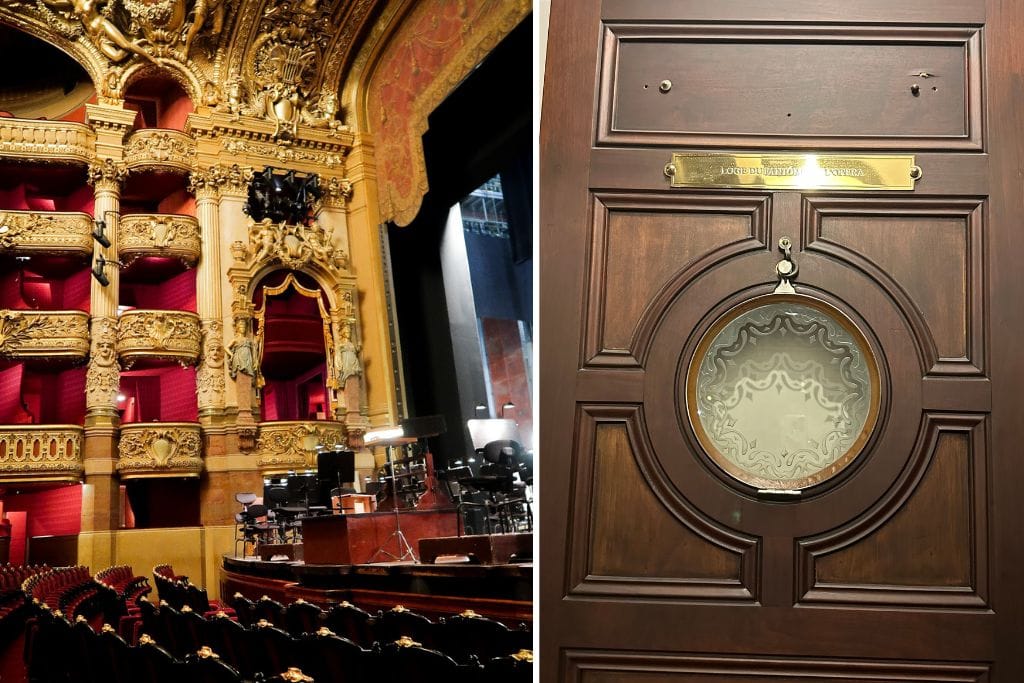
Similarly, Leroux created the character of the Phantom based on a couple of real-life individuals associated with the Palais Garnier.
One source was a pianist who suffered disfigurement during a fire that ravaged the Salle Le Peletier, the predecessor to the Palais Garnier, in 1873. The other story that Leroux drew from was the disappearance of an assistant to Charles Garnier during the construction of the opera house.
So as you can see, bits and pieces of real-life stories were used to generate the haunting presence and enigmatic persona of the Phantom that many of us have come to know and love.
Today, the Phantom of the Opera serves not only as a connection to real-life events of the past but also has immortalized the reputation of the Paris Opera House as one of the most famous and beloved cultural landmarks in the world.
7. Underground Lake Palais Garnier
The last fun fact about the Palais Garnier is that it has an underground lake right beneath the stage! During the excavation of the Palais Garnier in Paris between August and December 1861, an unexpected challenge arose. There was flooding due to the high groundwater level at the site. Despite immense efforts to lower the water level by pumping water out 24/7, not all the water was able to be removed.

To overcome this issue, Charles Garnier devised a brilliant engineering solution—a double foundation. This innovative design included a watercourse and a massive concrete cistern (casing) to oppose the pressure from the external groundwater and serve as a reservoir in case of fire. Think of it as a counterbalance.
And it was this underground lake that inspired a key plot point in Gaston Leroux’s iconic novel, “The Phantom of the Opera.” You’ll recall that Christine and the Phantom use a boat to cross the misty waters of the underground lake, more than once… Unfortunately, you won’t have a chance to see the lake up close. But, when you walk past the main stage, you can *peer into the darkness* underneath with the knowledge that the lake is not too far below
In the event that you haven’t booked housing for your stay in Paris yet, here are some places worth considering staying at. These are places I’ve researched and stayed at during my many trips to Paris! Each place has a high rating and is conveniently located within a 10-minute walk of a metro station!
Hostel Stay
- Check out my review of the hostel here
- The People Paris Marais — nice hostel near Notre Dame | ⭐️ 8.9 / 10
Low-Cost Stay
- Hôtel Vic Eiffel — boutique 3-star hotel with terrace | ⭐️ 8.8 / 10
- See my full review of this new hotel here
Mid-Range Stay
- Read my honest review of this boutique hotel here
- Chouchou Hotel — Super fun and eclectic 4-star hotel | ⭐️ 9 / 10
Luxury Stays
- Hôtel Le Walt Paris — 4-star hotel w/ Eiffel Tower views | ⭐️ 8.9 / 10
- InterContinnental Paris Le Grand — 5-star hotel by Opera Garnier | ⭐️ 8.8 / 10
- Four Seasons Hotel George V Paris — Luxurious 5-star hotel | ⭐️ 9.4 / 10
Alternatively, feel free to use the interactive map below to search additional housing options. You can input your specific travel dates and the number of people in your party for even more accurate prices 🙂
Yes, the Paris Opera House is open to the public every day from 10 AM to 5 PM. That said, it occasionally closes when there are daytime performances. The last entry is at 4:15 PM.
No, the Palais Garnier is not free. You can purchase an individual ticket for a self-guided tour here. Or, you can join a guided tour, which gives you an in-depth understanding of the secrets and history of the Opera House!
A Paris Opera House tour can last 1 – 1.5 hours. The one I did was 1.5 hours, and I wish it were longer because there’s so much fascinating history to uncover.
If you purchase just an entry ticket for a self-guided tour , I recommend allotting 1.5 – 2 hours for your Palais Garnier visit. The audio guide, which you can add on-site for €6.5 or ~$7.15 USD, lasts 1.5 hours.
The Palais Garnier was built from 1862 – 1875. It was officially open to the public on January 5th, 1875.
The Palais Garnier is in the 9th arrondissement.
I recommend visiting the Louvre , ascending to the top of the Eiffel Tower and the impressive Arc de Triomphe , partaking in the famous French gastronomic scene , wandering around the streets of Montmartre , and visiting the Musée de l’Orangerie . Oh, and, my favorite day trip is to Monet’s House and Gardens in the charming town of Giverny! But, many love visiting the opulent château that is Versailles 😉
Ultimately, I believe a visit to the Palais Garnier or Paris Opera House is an absolute must for anyone with a passion for breathtaking architecture, uncovering hidden stories, and connecting with the past. Not to mention, this is a chance to witness one of the world’s most famous opera houses up close and personal! Of course, like the city of Paris , the Palais Garnier may not be everyone’s cup of tea. So, whether you decide to visit or not, I hope this post has been insightful and helped you decide whether or not the Paris Opera House is worth visiting for you or not.
✅ 🎭 Click to book your entry ticket for the Palais Garnier or get a bundle ticket for the Opera House & a 1-hour Seine cruise ⛴

Read More About France
- Traveling to along the South of France? Here’s what to know about the gorgeous seaside town of Nice and Monaco, the glamorous principality that’s a just ride away from Nice !
- Fancy venturing to France’s west coast? Discover the affordable yet charming beach town of Biarritz! Here you can expect lots of surf, beautiful coastal views, and fun activities to fill your itinerary !
- Thinking of exploring the colorful city of Toulouse ? Here are some fun things to do during your visit!
Save This Post for Later!
Kristin is the founder of Global Travel Escapades, a blog dedicated to helping travelers explore beautiful destinations and planning their wildest travel dreams. She has explored 30 countries and is on a mission to visit 50 by age 30. Along the way, she has lived in places like sunny San Diego and the vibrant French capital! Ultimately, Kristin hopes her passion for adventure, delicious food, and all things F1 & tennis inspires others to plan their next travel escapade!
The Good Life France
Everything You Want to Know About France and More...
Back stage at the Paris Opera House | Palais Garnier
- Guest writer
- Arty , Culture & Icons , Paris

The Paris Opera House or Palais Garnier is one of Paris’ most magnificent buildings, a place of mirrors, gilt, lush and plush accoutrements. It was the cultural centre of Paris in the Belle Epoque years and continues to wow visitors with the ballets that are performed on its illustrious stage. Lisa Buros-Hutchins goes back stage at this very famous Paris landmark…
There is a place in Paris so beautiful, so magical in its timeless detail, that it moves me every time I visit it. The Palais Garnier is a visually stunning building so full of intricate architectural detail and majesty that I simply cannot think of another place in Paris that rivals it.
The Garnier was commissioned by Napoleon III to be built by the architect Charles Garnier. Twelve opera houses came before the Garnier, of which 11 went up in flames and the 12th just didn’t make the cut to be worthy of 19th century France. To make sure this majestic 13th opera house stands the test of time there is now an in-house team of pompiers (french firefighters) on duty and keeping watch over the Palais Garnier 24 hours a day.

Legend has it that the Emperor’s wife, the Empress Eugénie, who was thought to be peeved that Garnier had been chosen over her favourite designer Viollet-le-Duc, asked the relatively unknown Garnier: “What is this? It’s not a style; it’s neither Louis Quatorze, nor Louis Quinze, nor Louis Seize!” “Why Ma’am, it’s Napoleon Trois” replied Garnier “and you’re complaining!”

The Grand Foyer is breath taking as you stroll through it, losing yourself to the exquisite beauty of every story, person and myth represented on the painted ceiling and gilded light fixtures. And, of course, who can deny the vivid beauty of Marc Chagall’s ceiling perfectly lit by the six ton chandelier Charles Garnier himself designed to illuminate his celebrated opera house. The entirety of the Palais Garnier is, quite simply, a masterpiece.
It is the exclusivity of the Opéra Garnier that has always intrigued me the most. This mythic place of ballerinas, and the occasional opera, holds its secrets close. Gaston Leroux’s Phantom of the Opéra, which is based on this very opera house, certainly took the mystique to epic proportions. So, just imagine what it was like when I received an invitation to do an exclusive tour – a full on, all-access tour of this one place that I have held in such high regard, and been completely intimidated by, since my arrival to the City of Light.
I have to say what I love about the Palais Garnier is that here you have this world renowned opera house, steeped in tradition and closely guarded secrets of underground lakes and hidden cellars, an institution unto itself … and it just happens to have one of the most forward-thinking, young and dynamic teams I’ve had the pleasure to work with in Paris. I am always about giving my clients the most unique and most exclusive experiences I can come up with. And I certainly cannot do this without the help of the people who hold the keys to places like this! And here at the Palais Garnier it is Flore and Coralie, two exceptional ladies I work with quite a bit, who hold the golden keys to this kingdom.
When I arrived to tour the Palais Garnier with a few close friends I was like a small child who was getting to see Santa Claus – it was honestly that thrilling to me. We were led through the backstage area and into the ballerina’s warm-up room and my eyes were wide open with my hands over my mouth trying to conceal my giddiness. To stand on the stage – a stage so much bigger than you could ever imagine – was mind boggling at the scale and exclusivity of it. And then down the stairs we went to the mythical parts of the Palais Garnier…

We saw the rigging used to change the sets back in the day of the 1870’s and it was crazy cool to see how the stages were changed – talk about forward thinking! And, of course, to get to see the water reservoir was, quite honestly, the thrill of a lifetime. It wasn’t so much seeing it as it doesn’t really lend itself to what you expect from every Phantom of the Opera movie ever made: it was the simple fact that I was standing at the water reservoir of the Opéra Garnier knowing I was one of so few people who will ever have this amazing experience. And of course, the atelier where they mend, sew, create – you name it — hundreds of costumes, tutus and special accents to the dresses simply cannot be imagined. This whole other entity of the Palais Garnier that exists only to those with access to it is, without a doubt, very magical to see.
This mythical place in Paris known as the Palais Garnier truly does live up to every expectation I had, simply sublime.
Find out how to take a tour of the Paris Opera house on their website.
By Lisa Buros-Hutchins
Paris Opera – a mini Versailles
Latest Posts

Recipe for classic French lemon tart

Recipe for classic French frangipane and fruit tarts

How to make French style sweet pastry

Top wine experiences in the Golfe de Saint-Tropez

May Day in France Podcast

Luxury customized tours and vacations in France
Related posts.

Secret Paris and hidden gems

The Montmartre Funicular – Paris’s unusual railway!

The Catacombs of Paris

Superstitions and weird beliefs of the French
Get updates and stay connected - subscribe to our newsletter.
Everything You want to know about france and more…
The Good Life France is the leading independent website about all things French from travel to culture, gastronomy to property and practical guides & more…
Let's get social

IMAGES
VIDEO
COMMENTS
SELF-GUIDED TOUR. The Paris Opera offers you the possibility to discover the treasures of the Palais Garnier's public areas, a master piece of the 19th century theater art architecture. This ticket also gives you access to the current exhibitions (when available). Booking is strongly recommended. Full rate: €15.
75012 Paris. Access to the Bastille Opera. Metro: Bastille station (lines 1, 5 and 8, exit n°4 r. de Lyon) RER: Gare de Lyon station (line A) ... PALAIS GARNIER. Individuals. Self-guided tours +33 8 92 89 90 90 (€0.35/min) or on-site, at the desks or automatic terminals. Guided tours
from 10 a.m to 6.30 p.m. At the corner of the streets Scribe and Auber - 75009 Paris. At the counters of the Opera Bastille: from 2:30 p.m to 6:30 p.m (130 rue de Lyon - 75012 Paris) from Monday to Saturday (except public holidays) and one hour before the beginning of the performances on Sundays and holidays.
Sing! 7 minutes at the Paris Opera" offers original incursions into the season thanks to broadcasts produced by France Musique and the Paris Opera. For each opera or ballet production, Charlotte Landru-Chandès (opera) and Jean-Baptiste Urbain (dance), present the works and artists you are going to discover when you attend performances in our ...
Palais Garnier. 19,962 reviews. #9 of 3,551 things to do in Paris. Architectural BuildingsTheaters. Open now. 12:00 AM - 11:59 PM. Write a review. About. This opulent 19th-century opera house is known for its magnificent interiors and the amazing performances by the Paris Opera Ballet.
A: A self-guided tour of Palais Garnier costs €15 for most adults, €10 for reduced tickets, and is free for under-12s and the unemployed. Themed guided tours cost €23 for adults, €16.50 for reduced tickets, and €10 for under-10s. Tickets to operas, ballets, and concerts range from €35 to €300.
The Paris Opera offers you the possibility to discover the treasures of the Palais Garnier's public areas, a master piece of the 19th century theater art architecture. This ticket also gives you access to the current exhibitions (when available). ... Let Zoé ballerina of the Opera take you on a tour of Charles Garnier's architectural ...
Story: The Opera Garnier Guided Tour. Built in 1875 by architect Charles Garnier, the Palais Garnier is the largest opera house in Europe, housing more than 2,000 seats under its elaborate roof. As well as being regarded as the most prestigious of Paris' theatres, the Opéra Garnier is also one of the capital's most emblematic monuments, a ...
Palais Garnier Opera House Tour, Paris. About a month before visiting the Paris Opera House, my niece, her husband, and I ordered tickets online for the guided tour. We chose one of the morning, English-speaking tours. In addition to French and English tours, there are also Spanish-speaking tours with a maximum of 30 people. The cost of the ...
Book. Online, on the Tickets section. Via the Paris Opera app available on iOS and Android for smartphones and tablets. At the Palais Garnier Box office (at the corner of the rue Scribe and rue Auber - 75009 Paris): from Monday to Saturday (except on bank holidays) and from 10 am to 6:30 pm and 1 hour before the performances (including on ...
Paris Opera Ballet School Production. Opening Show. 7:30 pm - Ballet. Don Quixote. 7:30 pm - Ballet. 14. Public class with students from dance schools of the 21st century. 11 am - Ballet. Paris Opera Ballet School Production. 2:30 pm - Ballet. 15. Médée. 7:30 pm - Opera. 16. Paris Opera Ballet School Production. Finale. 7:30 pm - Ballet.
Take an incredible walking tour of the Palais Garnier, Paris' premier opera house, to see one of largest opera houses in Europe. The Opera Garnier, as it is often called, inspired the setting for the famous musical, 'Phantom of the Opera.' During the tour, your expert guide will show you the Grand Foyer, the sumptuous main staircase (Grand Escalier), the Member's Rotunda and the auditorium ...
Visitors can tour the main premises of the Opera Garnier during the day and visit the site's museum, either on an individual basis or as part of a guided tour. Opening Hours 10 a.m. to 4:30 p.m. (September 10th to July 15th); 10 a.m. to 5:30 p.m. (July 15th to September 10th).
This 19th-century architectural masterpiece was built by Charles Garnier at the wishes of Emperor Napoleon III. It's located at the Place de l'Opera, a square in Paris's 9th arrondissement. The insides of the Opéra Garnier boast some stunning Beaux-Arts architecture, like the 30-m high marble Grand Staircase.
Palais Garnier. 19,960 reviews. #10 of 3,549 things to do in Paris. Architectural BuildingsTheatres. Open now. 12:00 AM - 11:59 PM. Write a review. About. This opulent 19th-century opera house is known for its magnificent interiors and the amazing performances by the Paris Opera Ballet.
One of the world's best-known opera houses, Paris' Opéra Garnier offers opulent detailing and centuries of history—and this in depth private tour makes it easy to understand. Pick between morning and afternoon start times, meet directly at the Opéra Garnier, and head right in. Once inside, you'll learn all about its history from your guide's commentary, will admire its ornate ...
Pl. de l'Opéra, 75009 Paris, France. Open in Google Maps. Departure Point: Opera Garnier, central Paris Address: Opera Garnier, 75009 Paris Directions: The entrance for guided tours is located at the corner of Rue Scribe and Rue Auber, behind the statue of Charles Garnier. The meeting point is located in front of the Guided Tours counter ...
The Palais Garnier (French: [palɛ ɡaʁnje] ⓘ, Garnier Palace), also known as Opéra Garnier (French: [ɔpeʁa ɡaʁnje] ⓘ, Garnier Opera), is a historic 1,979-seat opera house at the Place de l'Opéra in the 9th arrondissement of Paris, France.It was built for the Paris Opera from 1861 to 1875 at the behest of Emperor Napoleon III. Initially referred to as le nouvel Opéra de Paris (the ...
This ticket gives access to the Palais Garnier's public areas : the Grand Escalier, the salons and foyers. For reasons related to theater activity, the performance hall is regularly inaccessible to visitors. €15. Select. Welcome to an architectural gem in the heart of Paris, on a self-guided tour. A masterpiece of refinement inaugurated in ...
Discover a unique and prestigious place in the heart of Paris: the Palais Garnier. Several visits are to be discovered: Intermezzo visit to the Palais Garnier: Through the rooms of the Opera accessible to the public, discover the extraordinary history of the Palais Garnier, a monument of architecture and a total work of art. Visit Palais Garnier in the Belle Epoque: Go back in time with ...
The opera house is a must visit attraction in the 9th arrondissement. A creation of Charles Garnier, it was part of Napoleon's great makeover of Paris. It's highly decorative, a mix of Beaux-Arts symmetry and Baroque and Renaissance elements. facade of the Opera Garnier. Visiting Paris' Opera Garnier is a dual-purpose immersive experience.
The novel and its various film and stage adaptations, particularly the 1986 musical, attract many visitors to the fabled Paris opera house. During tours of the Palais Garnier, tour guides will touch on some of the novel's highlights that correspond with features of the opera house like its seven-ton bronze chandelier.
Starting from 22,00 € Find out more. Written by Gaston Leroux and first published in 1910, The Phantom of the Opera is a fantasy novel whose action takes places primarily in the Palais Garnier. The extremely popular book has been adapted several times and is even partially responsible for the success of this legendary Parisian venue.
Overview. Make your visit to the Opera Garnier easy by booking an admission ticket online, which allows your to breeze past entrance queues. A self-guided visit means that you can explore at your own pace without the pressure of a tour group, tailoring the experience to your own preferences. Leave with a new perspective on Paris's history ...
4. Grand Staircase Palais Garnier. Arguably the most well-known image of the Opera House in Paris of the Grand Staircase. Crafted from exquisite white marble and adorned with a striking balustrade of red and green marble, the staircase splits into two divergent flights that gracefully lead to the Grand Foyer.
The Paris Opera House or Palais Garnier is one of Paris' most magnificent buildings, a place of mirrors, gilt, lush and plush accoutrements. It was the cultural centre of Paris in the Belle Epoque years and continues to wow visitors with the ballets that are performed on its illustrious stage. Lisa Buros-Hutchins goes back stage at this very ...